- Skip to primary navigation
- Skip to main content
- Skip to primary sidebar
- Skip to footer

Normandie Lovers
To awaken your senses in Normandy - Claire et Manu’s Blog

Visiting the Rouen Cathedral (tips + photos)
by Claire ROBINSON , Region Lovers | July 9, 2023 | no intrusive ads, no sponsored content, just some affiliate links - if you use them, we get a small commission (read more)
Are you visiting Normandy? Don’t miss a visit to Rouen Cathedral . Located in the heart of the city, it’s a jewel of Gothic architecture . Built between the 12th and 16th centuries, it’s sure to impress: it’s the tallest cathedral in France ! Made famous by the works of Monet , it’s a must-see in Normandy.
In this article, we invite you to discover the many treasures of the cathedral (stained glass windows, tombs of the Dukes of Normandy), a listed historic monument . You’ll also find all our tips in pictures to help you plan your visit!
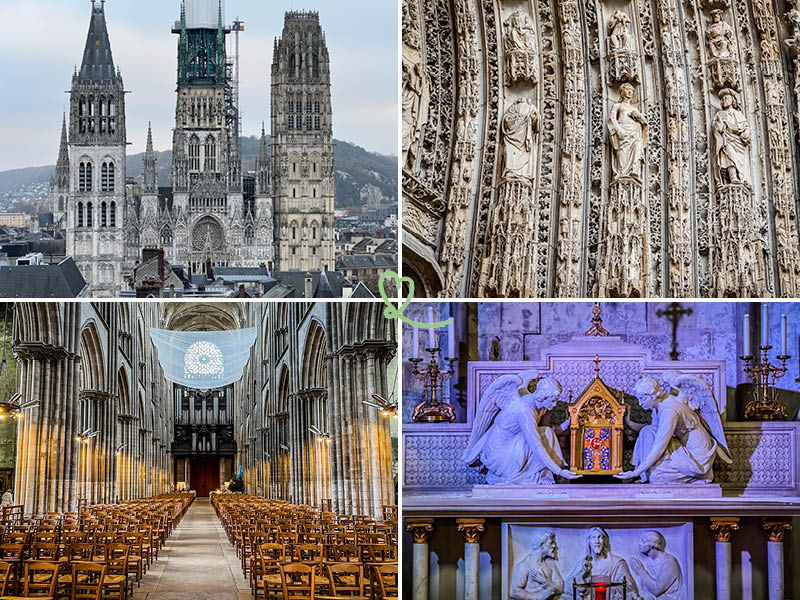
This review is completely independent , we visited the cathedral anonymously and paid our entrance fee in full.
Why visit Rouen Cathedral?
Is rouen’s notre-dame cathedral worth a visit.
Yes, there’s no denying it! In fact, we’ve listed it among our 15 ideas for visits to Rouen . In our opinion, Rouen Cathedral is one of the most beautiful in France. Its tormented history is captivating, and its beauty, emblematic of the flamboyant Gothic style, leaves you breathless. What’s more, it’s a monument that blends almost organically into the heart of the city, which sets it apart from other cathedrals. In Rouen, the houses are almost right up against the monument!

Why is Rouen Cathedral famous?
Rouen’s Notre-Dame cathedral is famous both in France and internationally, thanks to Monet, a leading figure in the Impressionist movement. The painter depicted it in a series of 30 paintings in the 1890s. The monument can be admired under different lights, in different seasons. This creates a real sense of intimacy with the cathedral, and gives it a certain contemporary feel.
But the cathedral is also famous for being the tallest in France, with its 19th-century spire rising to 151m!

What we liked best
A visit to Roeun Cathedral is particularly impressive, both inside and out. Here are our favorites:
- the façade and its portals: in our opinion, the façade is the most impressive part of the cathedral. You won’t forget its height and finely sculpted decorative abundance.
- the booksellers’ staircase: this elegant 15th-century stone staircase leads to the cathedral library.
- the Cour d’Albane and its garden: a calm, green space that takes us back to medieval times.

Video tour of the cathedral
Practical tips and map: rouen cathedral, france, where is rouen’s notre-dame cathedral.
Rouen Cathedral is located at 12 Avenue Aristide Briand in Rouen (76000), Normandy.
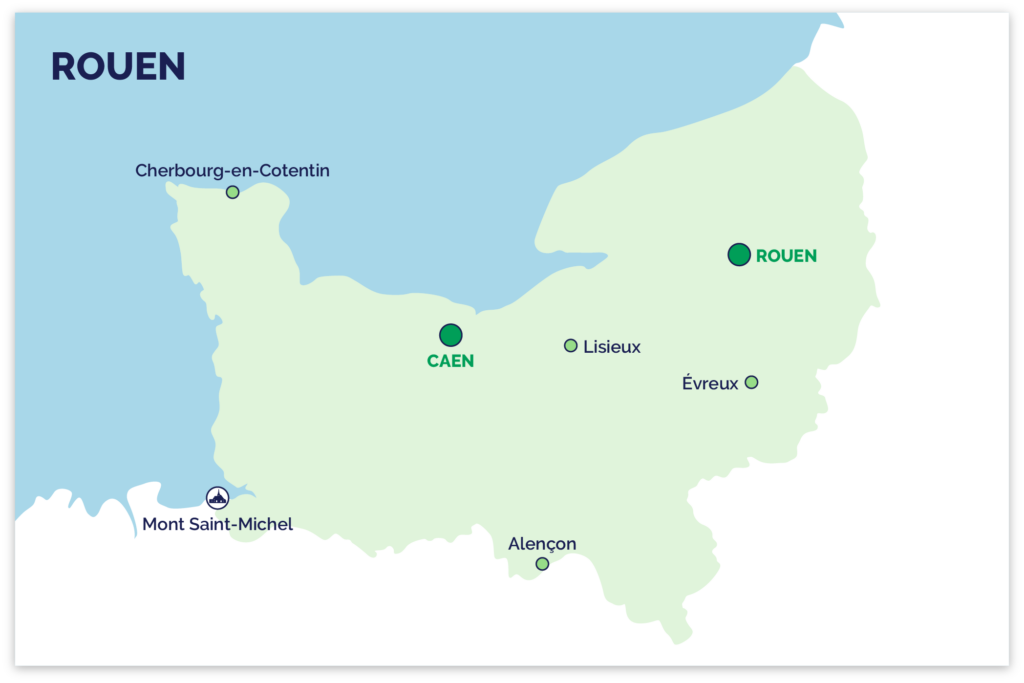
- Driving time from Evreux: 01h00
- Driving time from Caen: 01h40
- Driving time from Alençon: 01h50
- Journey time from Cherbourg: 02h50
- Journey time from Paris: 2h00
How to get there
Traffic in Rouen is difficult, especially at rush hour. If you’re coming from the Paris region or Normandy, prefer the train. Rouen railway station has a regular TER line serving Paris (between 1h15 and 1h30) and the main towns in Normandy (Caen, Le Havre…).
See available timetables and book your train and coach tickets now .
Once in the city, you’ll easily find the cathedral in the center of town. From the station, it’s a 25-minute walk. You can also take public transport, which will take you to the monument in around 20 minutes:
- TEOR bus lines: 1, 2, 3 Cathédrale stop.
- Fast bus lines: F1, F7 Arrêt République.
- Bus line 11: République stop.
To plan your journey, please visit the official Rouen Normandie transport network website .
Last but not least, you can rent bicycles in the city 24/7. The Cy’Clic station at Place du Vieux Marché, Square Verdrel / Beaux Arts, is in the immediate vicinity of the cathedral.

Parking in Rouen’s historic center can be tricky. If you want to be sure of finding a space quickly, we recommend you visit the cathedral parking lot. This pay parking lot is secure, open 24 hours a day and partly underground. You’ll find charging stations for your electric car.
OUR ADVICE FOR RENTING A CAR IN Normandy
- Compare prices on our preferred platform: DiscoverCars – one of the best rated sites.
- Choose a car that is comfortable enough (distances can be long) but compact (some parking lots and villages are narrow).
- Think of the complete insurance (some roads are tortuous and narrow).
- There is a lot of demand, book it early .
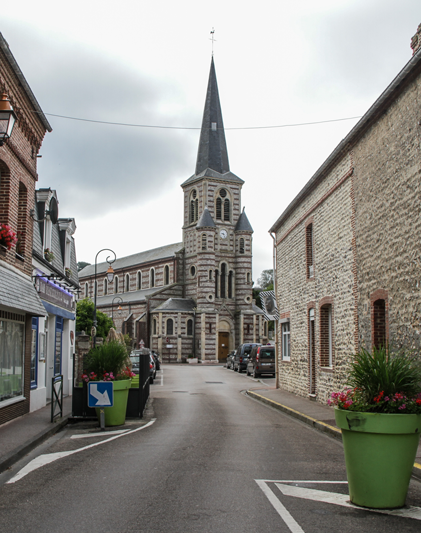
Practical information
To admire the cathedral in detail, while reading the explanatory panels, allow between 1h and 1h30 for the visit.
Rouen Cathedral is accessible to people with reduced mobility, as its forecourt is on one level. Special access is also available via the Portail des Maçons on rue du Change. Although the historic heart of Rouen is paved, the cathedral’s floor is rather smooth. A ramp makes the choir accessible to all. The floor has been levelled to facilitate access to the baptistery, while the nave is open on a slope at the level of the Saint-Siméon door. An elevator is installed next to the bookshop. Despite this, some areas are difficult to access, such as the Tour Saint-Romain and the Tour de Beurre. Audiovisual animations available on a projection screen in the Saint-Etienne chapel compensate for this shortcoming.
Cathedral documentation is also available in Braille and large print.
Pets are not allowed inside the monument, with the exception of guide dogs. You’ll find public toilets open from 6am to 10pm on rue des Bonnetiers (on the side of the cathedral).
Schedules and rates
Notre-Dame de Rouen Cathedral is open:
- April to October : 7:30 a.m. to 7 p.m. weekdays, 8 a.m. to 6 p.m. Sundays and public holidays.
- November to March: 7.30am to 12pm and 2pm to 6pm on weekdays, and 2pm to 6pm on Sundays and public holidays.
The cathedral is closed on Monday mornings, January 1, May 1 and November 11.
Please note that the ambulatory closes 30 minutes before the cathedral’s closing time.
Visits to the cathedral are free of charge.

Subscribe to our Newsletter
- Get away from it all with Region Lovers’ beautiful destinations!
- Once a month
- Advertising-free

Guided tours
Guided tours allow visitors to discover areas usually closed to the public, such as the crypt.
They take place at 2:30pm:
- Saturdays and Sundays all year round.
- Every day of the week during the Christmas and February school vacations (zones B and C), the Easter vacations (zones A, B and C) and the summer vacations (from July to the Heritage Days in mid-September).
More specific, themed tours are also available on request. Find out more on the official tourist office website .
If you want to see all Rouen’s must-see sights in one visit, you can opt for a tour with a local guide . There are also tours focusing on the secrets of the Normandy capital or its sweet culinary specialties .

Where to eat in Rouen
You’ll find plenty of restaurants in Rouen’s historic center. Here is our selection:
- Dame Cakes : housed in a former wrought-iron workshop, this tea room is Emmanuel’s favorite, offering succulent pastries (cakes, tarts, crumbles…) and wedding teas! From the room on the 1st floor, you’ll have a superb view of the cathedral. Dame Cakes is a must for any gourmet break in Rouen!
- Le Cap Vers: a restaurant a stone’s throw from the Seine specializing in world cuisine, revisited with fresh, local produce.
- Le XXI: refined cuisine in a restaurant whose concept is to change the way we look at disability.

WHERE TO STAY IN Rouen
Option 1: in the old town center
A charming historic heart, museums and attractions around every corner… We recommend..:
- Gustave Flaubert Literary Hotel with lots of quotes – see prices, photos and availability .
- Hôtel de Bourghteroulde set in a 16th-century residence – see prices, photos and availability .

Option 2: near the station
Just a 10-minute walk from the historic center, you’ll find more modern options. We recommend..:
- Blu Radisson Hotel next to the Jeanne d’Arc Tower – see prices, photos and availability .
- Hotel de Dieppe Best Western and its Art-deco ambience – see prices, photos and availability

See all our reviews of the best hotels in Rouen
Monet and Rouen Cathedral
Why paint rouen’s notre-dame cathedral.
Before delving further into the cathedral’s captivating history, let’s start with a detour into Claude Monet’s canvases, which revealed all its beauty. Claude Monet, although born in Paris, was raised in Normandy. After training in Paris, where he met Renoir, Monet took part in group exhibitions, developing an aesthetic aimed at pictorially translating optical phenomena linked to light and color. His work “Impression, soleil levant” (Musée Marmottan Monet, Paris), gave its name to the new Impressionist movement. In 1883, the painter set up his studio in Giverny. Located 72km from Rouen, we’ll soon be devoting an article to this charming village.
It was at this time that Monet achieved international success, thanks to the art dealer Durand-Ruel, who introduced him to the United States. The painter worked on a series of canvases, such as “Les Meules” and “Peupliers”, painted en plein air near his studio.
Claude’s brother Léon Monet settled in Rouen. The painter spent four periods in the Normandy capital, undoubtedly influencing the choice of subject for his future series of canvases: the cathedral.

The cathedral series
In the spring of 1892 and 1893, Monet devoted himself to his most ambitious project: painting the cathedral according to variations in light at different times of day. His first paintings, done en plein air in February 1892, depict the Albanian court. He sets up his studio in an apartment on Place de la Cathédrale, at the west corner of Rue du Gros-Horloge. This enabled him to paint two pictures of the cathedral’s main portal, seen from the front.
Monet moves again to his apartment on the cathedral square, to paint nine canvases of the cathedral portal, this time in perspective.
For an unobstructed view of the western facade and its many details, he then moves to the 1st floor of the Bureau des Finances, a 16th-century building that today houses the tourist office. It was on this occasion that he was most productive, producing eleven of the most colorful paintings in the series.
Finally, from February to April 1893, he began his last series of six paintings. In his new studio at 49 rue Grand-Pont, he now has a perspective view of the portal on the western façade and the Saint-Romain tower. Monet then painted up to 14 versions at a time, switching from one painting to another according to the changing light at different times of the day. This series, presented in 1895 in the Durand-Ruel gallery, won the admiration of Monet’s contemporaries and gave the cathedral international renown.

Where can you admire Monet’s cathedrals?
The 28 works in the cathedral series are now housed in prestigious museums in France and abroad (Museum of Fine Arts, Boston; Fondation Beyeler, Basel; Moma; Getty Center, Los Angeles; National Museum, Belgrade).
In France, you’ll find five paintings from the series at the Musée d’Orsay, including the famous “Le Portail (temps gris)”. Also in Paris, head to the Musée Marmottan-Monet to admire “La Cathédrale de Rouen, façade, soleil couchant”.
Finally, the Musée des Beaux-Arts de Rouen holds “La Cathédrale de Rouen. Le Portail et la tour d’Albane. Temps gris” (above): reason enough to visit the museum after the cathedral! Discover our article dedicated to the Musée des Beaux-Arts de Rouen.

USE OUR GUIDE TO PLAN A DREAM TRIP TO Normandy
All the information you need for your trip:
- 8 maps that make planning easier
- 160+ pre-selected locations
- Practical advice
- 300+ photos to help you choose
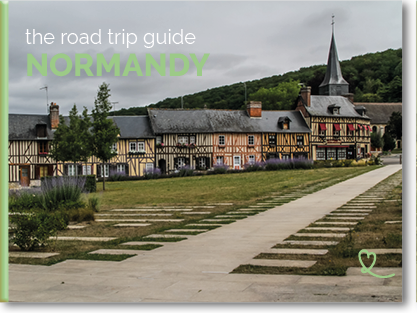
The architecture of Rouen Cathedral
The western facade and its portals.
After this artistic detour, let’s return to reality with an exploration of its truly exceptional architecture. The western façade, built between the 12th and 16th centuries, is the widest in France (61m). It was partly rebuilt in the 16th century, after the work on the Beurre tower, which we’ll talk about next. The exceptional duration of this project offers a complete architectural panorama of the Gothic style, from primitive to flamboyant Gothic, with its intricate carvings that foreshadow the entry of the Renaissance style.
The classical Gothic style is evident in the rows of 14th-century statues depicting the bishops of Rouen, apostles and prophets. We were pleasantly surprised by the bell towers on the façade, modelled on English cathedrals (Wells…).

The façade is also remarkable for its three portals:
- Saint-Jean portal : to the north of the western façade, its geometrically designed voussoirs are remarkable. The tympanum, dating from the 3rd quarter of the 13th century, depicts scenes from the life of Saint John the Baptist.

- Saint-Etienne portal : to the south of the western façade, this portal is more classical in style. The voussoirs feature a floral theme, while the tympanum, dating from the 3rd quarter of the 13th century, depicts the stoning of Saint-Etienne.

- The Saint-Romain portal : the central portal of the façade, it’s also the best known. Emblematic of the flamboyant Gothic style, it features a sumptuous rose window and tympanum depicting the tree of Jesse and its descent to the Virgin Mary, to whom the cathedral is dedicated. It’s our favorite!

The towers of Rouen Cathedral
The cathedral features two towers on its western façade:
- Tour Saint-Romain (north): 82m high, it features a 12th-century lower section, corresponding to the early Gothic period. Several levels of increasingly large bays follow one another up to the upper floor, in flamboyant Gothic style (14th century), topped by a slate roof decorated with 4 gilded suns. This is the site of the cathedral’s carillon, one of the largest in France.

- The Tour de Beurre (south) : 75m high, it is characteristic of the flamboyant Gothic style. Its 4 levels are punctuated by buttresses enriched with niches housing statues. We found this tower very beautiful, with its pinnacle crown that inspired the architects of Chicago’s Tribune Tower.

The cathedral’s third tower, known as the “Lantern Tower”, is located at the crossing of the transept. Its three levels date from the 13th and 16th centuries respectively. The most recent part is marked by the Renaissance style, with statues nestling under canopies adorned with shells. In 1523, a 1st wooden spire was installed, but was destroyed by fire in 1822. A cast-iron spire replaces it, reaching 151m. Just like us, you’ll be impressed!

Transept portals
When visiting the cathedral, don’t just look at the main façade! The building’s transepts are also adorned with beautiful portals:
- The Libraires portal (north transept): built between the late 13th and early 14th centuries, its architecture is inspired by the transept of Notre-Dame cathedral in Paris, with its rose window and gables. Its tympanum depicts the Last Judgement. The 15th-century canons’ library adjoins the portal, which opens onto the booksellers’ courtyard. In our opinion, this is the cathedral’s most elegant and distinctive portal.

- Portal de la Calende (south transept): built at the same time as the portal in the north transept, the influence of Notre-Dame de Paris can also be seen here. The rose window is surmounted by a sculpted group depicting the Coronation of the Virgin, while the tympanum illustrates the Paschal Mystery.

The Albane chevet and courtyard
Don’t forget to take a look at the back of the cathedral! We admired its chevet, enclosing the chapel of the Virgin. Its pointed-arch windows are topped with Gothic curves. Amid the pinnacles stands a 16th-century golden Madonna. The south side of the choir, facing rue des Bonnetiers, features 13th-century religious buildings (sacristy, vestry, etc.).

Finally, we enjoyed the gardens of the Cour d’Albane, adjoining the cathedral. The garden follows the lines of the cathedral’s unfinished cloister, begun in the 13th century. This green space, calm despite the hustle and bustle of the city center, is punctuated by architectural features from the monument’s renovations. In all, 8 gardens have been laid out according to historical themes recalling the past of this 2,000m2 courtyard. Archaeological digs in 1987 and 1991 revealed that the courtyard had also been home to an ancient villa, a medieval chapel and a 15th-century bell oven.

The riches of Rouen Cathedral
The nave, baptistery and side aisles.
When we entered the monument, we were surprised: the interior seemed less vast than we had first thought. This is quite normal, as the towers of the façade are not aligned with the nave. This one, though sober, is elegant. Dating from the 13th century, it has 11 bays and rises over 4 levels, a typical feature of early Gothic architecture. Don’t forget to look up at the vaults, particularly the highest (54m) at the transept crossing at the lantern tower. This is also where you’ll find our favorite feature of the visit: the booksellers’ staircase, or Bibliothèque du Chapitre staircase, leading to the archives floor.

Take the time to observe the aisles, the side aisles of the nave. You’re about to see something that only exists in Rouen Cathedral: on each pillar, you’ll notice that the vaults rest on sets of 5 colonnettes. We found it particularly beautiful.
Take a tour of the baptistery, the lower room of the Saint-Romain tower. This will give you the chance to see an example of Romanesque architecture in the oldest part of the cathedral, with the crypt (accessible by reservation only at the tourist office ).

Remarkable chapels
The cathedral is home to many remarkable chapels. Here’s our selection of chapels not to be missed during your visit:
- Chapelle Saint-Etienne-la-Grande-Eglise (lower room of the Tour de Beurre): located right next to the store, this chapel has long been a separate parish church. The 19th-century altarpiece by Fulconis caught our eye. It depicts the Last Supper, the martyrdom of Saint Stephen and the Crucifixion. Various tombstones are also visible. Examples include the praying figure of Claude Groulard, first president of the Parliament of Normandy in the 17th century, and the recumbent of his wife.

- Chapelle Sainte-Catherine: the only chapel to have been spared the bombardments of the Second World War, it is richer than the others. The altar, altarpiece and panelling date from the 17th century. The paintings illustrate the life of Saint-Brice, bishop of Tours in the 5th century. The 16th-century altarpiece depicts the flagellation.

- Chapelle des Fonts: take a look at the 17th-century Spanish-style altarpiece in gilded carved wood. It was donated to the cathedral by Spain in 1937.

- Chapelle Sainte Jeanne d’Arc: dedicated to Joan of Arc, condemned in Rouen, the 1956 stained glass windows by Max Ingrand tell the story of her life. In the center is a statue of Joan of Arc, also from the 20th century. To find out more about the story of Joan of Arc, visit our article on the Historial Jeanne d’Arc .

The choir, ambulatory and recumbent statues
The choir dates from the mid-13th century. With its round pillars, it gave us an impression of lightness and elegance. The apse, with its 3 levels largely occupied by stained glass windows, brings a lot of light to this part of the building. The capitals are decorated with foliage and men’s heads.
The gilded bronze high altar is decorated with ears of wheat, leaves and bunches of grapes. It was cast in 2011 at the famous Coubertin foundry and was designed by architect Pierre-André Lablaude (responsible for the Versailles estate, restoration of the Mont-Saint-Michel abbey …) and artist Angelika Potier.

In the ambulatory, you’ll see the original statues on the façade, as well as numerous tombs of the Dukes of Normandy. The one that stands out the most, and also the most famous, is that of Richard the Lionheart.
We didn’t have the chance to visit the chapel of the Virgin, which was closed for renovation at the time of our visit. If possible, however, we recommend a visit (booking required at the tourist office ). It is famous for its Renaissance tombs of the cardinals of Amboise and the seneschals of Normandy. It features the Adoration of the Shepherds by 17th-century painter Philippe de Champaigne and sumptuous stained-glass windows.

The cathedral’s stained glass windows
The cathedral boasts a fine collection of stained glass from the 13th to the 20th century. The stained glass windows were installed progressively during the cathedral’s construction. One of the oldest examples is the booksellers’ rose in the north transept. The stained glass windows in the nave were replaced after the Hundred Years’ War. The creation and maintenance of the new stained glass windows were entrusted to Rouen master glassworker Guillaume Barbe, who worked from 1456 to 1488. Stained-glass windows from his studio can still be seen in most of the cathedral’s chapels.

In the Saint-Sever chapel, you’ll see what has become known as the “belles verrières”. It’s actually a blend of primitive 13th-century stained glass (upper sections), with additions by Guillaume Barbe, depicting scenes from the Passion.

We also enjoyed the stained glass windows in the chapel of Saint-Etienne-la-Grande-Eglise. The first series of windows depicts Saints Peter, Andrew, James the Greater, John the Evangelist, Paul and Jude, while the second series illustrates the Glorious Life of Christ. Although these stained glass windows date back to the 16th century, their authors are still unknown.

Finally, don’t be surprised to see some contemporary stained glass. They were created by Max Ingrand (1908-1969), one of the best-known post-war painters and designers. Although dating from 1956, these stained glass windows blend in well with the rest of the building. For example, they have been installed in the chapel of Saint-Léonard. Indeed, some of the cathedral’s original stained glass windows have been damaged in the course of its turbulent history.

PLAN YOUR TRIP TO Normandy
Inspiration destinations
- Deciding where to go in Normandy – the best destinations
- Our weekend ideas: best-of , romantic , unusual , seaside , luxury , family
- 16 seaside hotels in Normandy
- The most beautiful charming hotels in Normandy

- Best things to do in Normandy
- Best cities in Normandy
- Most beautiful beaches of Normandy
- Most beautiful villages of Normandy
- Best castles of Normandy
- Best abbeys of Normandy
- Read our complete guide to visit the Mont-Saint-Michel
- Discover the D-Day sites

- Where to stay in Normandy – best places and hotels
- See our tips for renting a car at CDG airport , Orly airport , Beauvais airport , Caen , Rouen , Bayeux …

A little history
Paleochristian and romanesque periods.
Speaking of troubled history, we’d like to give you a few pointers to help you better understand this building. The cathedral’s history dates back to the 4th century, with a building composed of 2 religious edifices, which was destroyed in the 9th century by the Vikings. In the 10th century, Rouen became the capital of the duchy of Normandy. A new basilica serves as a necropolis for the first dukes of Normandy, such as Rollon, whose recumbent is visible in the ambulatory, and Richard the Lionheart.
The cathedral was built in Romanesque style from 1020 onwards. The crypt was also created to enlarge the building. It was consecrated in 1063, in the presence of William the Conqueror.

The construction of the Gothic cathedral
Around the middle of the 12th century, Archbishop Hugues d’Amiens decided to modify the monument. He added the Saint-Romain tower in 1145. Doubtless influenced by the beginnings of the Gothic style at Saint-Denis Cathedral, the next archbishop, Gautier the Magnificent, had the Romanesque nave demolished in 1185. Construction of the Gothic elements was almost complete by 1240. Only the axis chapel, the western façade, the canons’ cloister and the transept portals were built in the early 14th century. It was not until the end of the Hundred Years’ War that the Tour de Beurre (completed in the 15th century) and the top floor of the Tour Saint-Romain were completed in the flamboyant Gothic style.

Fire, damage and restoration
Like most cathedrals, Notre-Dame Cathedral has undergone a number of fires and damages that have accelerated its transformation process. The first fire, in 1200, largely destroyed the Romanesque edifice, precipitating its evolution into the Gothic style. In 1562, during the Wars of Religion, Huguenots (Protestants) ransacked the cathedral’s furnishings and statues. A storm then devastated the monument (facade, rose window, crowning turret…). Thanks to a gift from Louis XIV, the building was restored. It was preserved during the French Revolution, serving as a concert hall and hayloft. Lightning destroyed the Renaissance spire of the Lantern Tower in 1822, and it was replaced by the current Gothic bronze spire.
Allied bombing during the Second World War destroyed most of the cathedral (roof structure, nave aisles, side chapels, then the Saint-Romain tower). The building was saved in extremis. Restoration work enabled the cathedral to be reopened in 1956. In 1987, the roof of the Saint-Romain tower was restored. Following the storm of 1999, the choir vaults were breached. Since 2010, major restoration work has been underway to consolidate the cathedral’s structure and buttresses.

Frequently asked questions:
When can you see rouen cathedral illuminated.
Every summer at dusk (June to September), the cathedral’s facade is brought to life by a sound and light show.
The themes of the shows change every year, but remain linked to the history of Rouen and the cathedral (Impressionism, Joan and the Vikings, the epic of William the Conqueror…): a good excuse to come back and see the cathedral regularly!

What’s on at Rouen Cathedral?
Numerous concerts are organized at the cathedral, and not just religious ones (Rouen University Hospital choir…). We invite you to consult the calendar on the cathedral’s official website .
What tourist attractions are nearby?
Many tourist attractions are located close to the cathedral, including museums and monuments:
- Château de Rouen and Tour Jeanne d’Arc: this keep is the only vestige of Rouen castle, built in the 13th century.
- Historial Jeanne d’Arc : a museum where you can discover the life of Joan of Arc (see our dedicated article ).
- The Gros-Horloge: a 14th-century clock emblematic of Rouen! (see our dedicated article coming soon).
- Musée des Beaux-Arts : (see our dedicated article ).
- Abbatiale Saint-Ouen – Rouen: all that remains of this former 16th-century Benedictine monastery is its church.
- Musée d’Histoire Naturelle de Rouen : (see our dedicated article coming soon).
- Musée maritime fluvial et portuaire: traces the history of the port of Rouen (see our dedicated article).
- Musée Flaubert et d’histoire de la médecine: located in the house where Flaubert was born, this museum displays objects that once belonged to him (see our dedicated article soon).

Are there any interesting anecdotes about the cathedral?
Several anecdotes are linked to the cathedral:
- The name of the Tour de Beurre : There are 2 possible explanations for its name. First, there’s the color of the tower’s stones, which are more yellow than those of the rest of the building. Historians, however, believe that this had more to do with the financing of the tower: the Archbishop of Rouen had authorized the people of Rouen to eat butter during Lent in exchange for a tax used to build the tower.
- The statues on the façade are actually copies: it’s true! Most of the originals are located in the ambulatory, to protect them from the elements and pollution.
- The tripartition of Richard the Lionheart’s body: the cathedral retains only the heart of the King of England. His entrails are located in Châlus (Haute-Vienne) and his body is buried at the Abbaye Royale de Fontevraud. To find out more, visit our article dedicated to the abbey!

What Masses are held at Rouen Cathedral?
Sunday mass is celebrated every Sunday and holiday from 8:30am to 10:30am. From Tuesday to Saturday, mass is at 10am. Vespers is at 5pm every Sunday during Advent, Christmas, Lent and Easter. Finally, the sacrament of reconciliation takes place on Mondays, Tuesdays, Thursdays and Fridays from 4pm to 5:30pm, on Wednesdays from 2:30pm to 5:30pm and on Saturdays from 11am to 11:45am and from 3:30pm to 5:30pm.
All our tips in this article were put into words with the help of Fanny.
Region Lovers' 10 commitments
- Visit all the places we tell you about.
- For each city, stay in at least one hotel and visit the ones we recommend.
- For each city, eat in at least one restaurant, visit the ones we select.
- Pay all our invoices in full, refuse any partnership or sponsorship.
- Periodically update our articles, with the help of our readers.
- Enrich our articles with our first-hand experiences.
- Use 99% of our own photos
- Use digital tools in a reasoned and transparent way, feeding them with information verified on site.
- Provide information on the traveler/writer pairing that gave rise to the article.
- Tell you what we do, and do what we tell you!
Claire and Manu
Find out more about the team and our history.

SEARCH OUR SITE
Our multi-destination blogs.
Regionlovers.fr
ZigZagroadtrips.com
OUR OTHER REGIONS TO DISCOVER
LoireLovers.fr
CorsicaLovers.fr
ProvenceLovers.fr
CanariasLovers.com
CHANGE LANGUAGE
Legal Notice / Terms of Use / Privacy Policy

- The Cathedral, intimate and flamboyant
It is one of the most famous Gothic cathedrals in the world thanks to the series of paintings that Claude Monet, the master of the Impressionists, dedicated to it. In the heart of the historic city, Rouen Cathedral sums up the evolution of Gothic art, since the beginning of its construction in the 12th century, on the foundations of a 4th century basilica and an 11th century Romanesque complex.
A flamboyant icon
Destroyed during the Vikings invasions in 841 and then partially, in 1944, by the Allied bombardments , Rouen Cathedral is a living building in perpetual evolution. It is also considered “the most human of cathedrals” due to its asymmetrical western facade, a true testament to 700 years of architectural evolution, the result of the labor of several generations of craftsmen.
Watch the 12th-century St. Roman Tower , which houses the most imposing carillon in France. Observe the decorations of the portal des Libraires and that of the Calende dating from the 14th century. Contemplate the beauty of the western facade with its unusual width of 61m and 70 carved figures. Amuse yourself at the Butter Tower , which since the 16th century has taken its name from donations made by diocesans to obtain the right to eat butter during Lent. And get giddy at the cast iron spire , built in the 19th century, which rises to 151m.
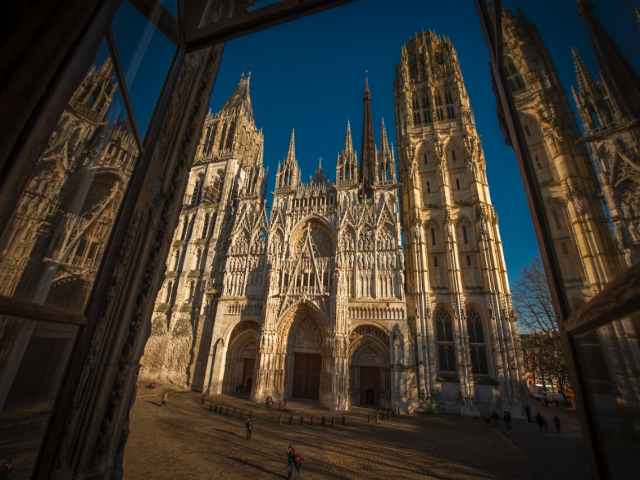
One of the most famous Gothic cathedrals in the world
It is an exceptional journey through the Gothic period that Rouen Notre-Dame Cathedral offers us. Here we can follow the evolution of the style over several centuries. The 12th century Saint-Romain tower, the 14th century Librarians’ portal and Calende portal, the 15th and 16th century western facade and Butter tower, and the 19th century cast iron spire. The facade of the Cathedral is richly decorated with 70 figures , sculpted between 1362 and 1421. Also, it has the particularity, rare in France, of preserving its archiepiscopal palace and its adjacent buildings .
The highest spire in France
The lantern tower is topped by a cast iron spire that rises to 151m. It is the highest in France . Destroyed by lightning in 1822, it was imagined by the architect Jean-Antoine Alavoine who then proposed to use cast iron, a very modern material for the time, less combustible than wood and lighter than stone. At the time of its inauguration, the spire was even the highest in the world! Inside the Cathedral, in the choir, are the burial place of Rollon , founder of the Duchy of Normandy, and the heart of Richard the Lionheart who had it deposited here in “remembrance of love for Normandy.”
Guided tour
What if we told you to take a mirror and chalk to visit the cathedral? The guided tour “Cathedral Measures and Excesses” is unprecedented and appeals to your senses. Feel the vertigo of the dimensions of the monument, soak up the resonance of its acoustics and play with the principles of its Gothic architecture . Equipped with rope, headphones and various tools, you are the actor of your visit. Nave, transept, choir have no more secrets for you. You become aware, sensorially, of the richness of this exceptional building.

An emotional beauty
Claude Monet made no mistake about it. Overwhelmed by the beauty of the Rouen Cathedral , he painted it tirelessly in series of paintings that became masterpieces that toured the world. Between 1892 and 1893, the master of Impressionism painted the monument from different vantage points and at different times of day. In particular, he depicts the cathedral as seen from the Albanian courtyard. These canvases were first done outdoors, then in a studio on the second floor of the Bureau des Finances , today’s tourist information point in Rouen . It produces twenty-eight views of the western portal at different times of the day according to the variations of light.
As long as the sun is on it, there will be as many ways of being Rouen Cathedral as man can make divisions in time.
An exceptional carillon
It is the most imposing in France and has been fully restored for the pleasure of visitors’ ears and eyes. For those who would like to get up close and personal with it, you must climb the 150 steps of the St. Roman Tower to reach the famous carillon ! A visit with a guide and the carillonneur himself allows us to observe the prodigious mechanics of the instrument up close. Here we discover the keyboard made up of keys that the carillonneur presses with his fists to operate the 64 bells that we can hear from 5km away. Each of them has a name: Joan of Arc, Germaine… For you to discover them!

Unusual visits
Want to go down into the remains of the Cathedral? Some places, usually closed to the public, open up during “ Unusual Cathedral ” tours, revealing a little more of the prestigious building. We can thus enter the Virgin Chapel or rush into the Romanesque crypt to go back to the source of the monument’s construction on which the builders based their work, around the year 1000, to build the Gothic edifice. A candlelight tour “If Objects Could Talk” takes you, by night, to meet the Cathedral’s inhabitants.
*This tour takes place from November to March each year. Next available for booking starting in October 2023.
Cathedral of light
Every summer , as night falls, the C cathedral metamorphoses into a sound and light show of great beauty. Themes change regularly, taking us into the epic of Joan of Arc , the Viking adventure or the impressionist movement . Collections that are always magical at the crossroads of history and modernity. The new technologies of these monumental projections make this giant of Rouen’s heritage vibrate.
You will dream, eyes wide open!

Organize your visit

What could be better than the intimacy of the night to meet the great local names who rest in this “Père Lachaise of Rouen”. Between funerary art, a walk to the sound of local stories and the light of our candles, we will spend a moment suspended, out of time.

This original tour appeals to your senses and reveals a little more of the beauty of Rouen’s cathedral. Feel the vertigo of its dimensions, soak up the resonance of its acoustics and play with the principles of its gothic architecture.

At the top of the Saint-Romain tower, the Cathedral’s carillonneur will show you, with a guide, the fabulous carillon and its 64 bells. Fully restored, it is the most imposing in France. A most singular heritage and musical experience.
Guided tour followed by a 30-minute musical audition.
You will also like
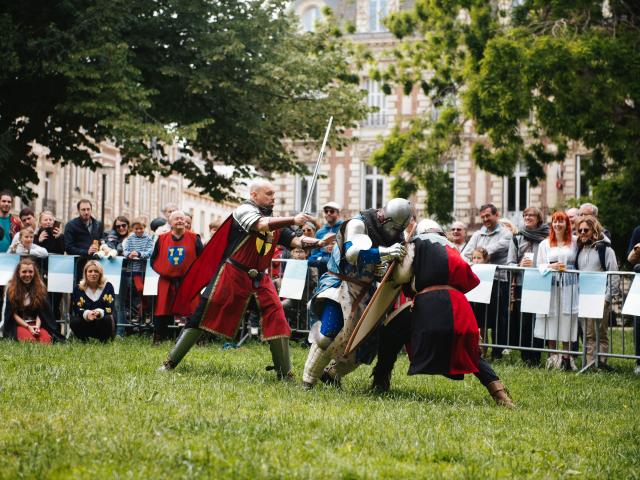
- 0 Favorites
Cathédrale Notre-Dame de Rouen
Normandy Tourism, France
- Active & outdoor
- Lifestyle & Wellness
- Discover Normandy
- Plan your trip
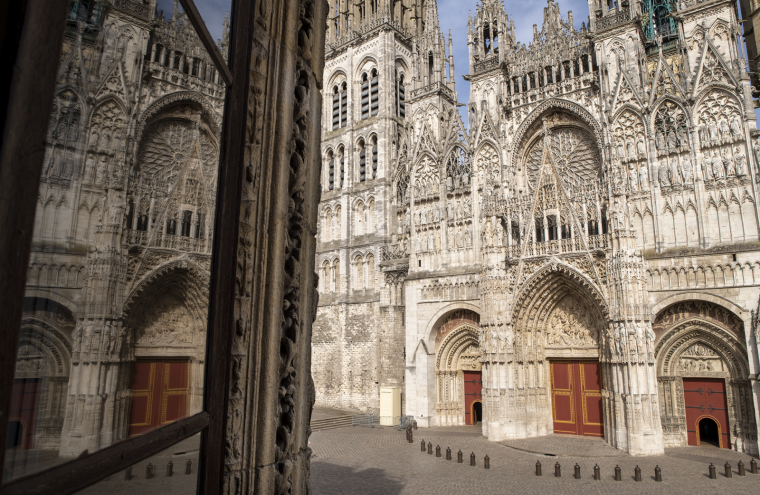
- Contact details
Return to list
It took several centuries to build the Cathedral, and it is in itself a display of each successive stages in the development of the Gothic style. The Tour Saint-Romain (12th century) ; the Portail des Libraires and the Portail de la Calende (14th century) ; the West façade and Tour de Beurre (15th and 16th centuries) ; the cast iron spire (152 metres high - 19th century). Beautiful stained glass windows.
Free for all
Payment methods
- Carte bleue
- Eurocard - Mastercard
- Contactless payment
- Money transfer
- Groups welcome
Proche (962m)
Work out my route
Contact Cathédrale Notre-Dame de Rouen
Return to top
Are you already in Normandy?
Plan what to see and do while you’re here by visiting normandy-secrets.com, which lets you in on all of the local secrets and hidden gems in the immediate vicinity!
Close search box
Visit Rouen Cathedral – Gothic at its Best in Normandy
The magnificent Gothic Rouen Cathedral has the tallest church spire in France and a wealth of art, history, and architectural details.

Rouen Cathedral ( La cathédrale primatiale Notre-Dame de l’Assomption de Rouen ) is one of the most impressive Gothic churches ever built. Construction dragged on for three centuries allowing all forms of the Gothic spectrum from early to high, flamboyant, and late to feature in the main structures. The spire is even Neo-Gothic – added in the 19 th century, it is the tallest church tower in France. The dukes of Normandy were traditionally crowned here and several are buried in the cathedral, including the heart of Richard the Lion Heart. Joan of Arc was put on trial in the bishops’ palace. The church has some stained-glass windows from the early-13 th century and the oldest recumbent tomb statue in France.
The Building of Rouen Cathedral
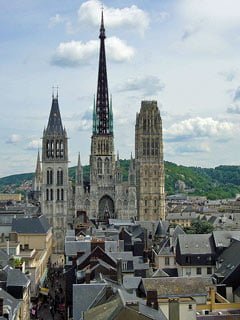
Rouen Cathedral is built on a site that has been used for Christian worship since at least the early 4 th century. Most of the present church was constructed between 1200 and the early 16 th century.
Construction of the current church started during the late-12 th century to modernize and enlarge a Romanesque cathedral. A fire during Easter 1200 caused major damage to the structure allowing the new Gothic church to be built freer from the constraints of the Romanesque predecessor.
Construction of the Gothic cathedral resumed shortly afterward but the Hundred Years War, revolts, finances, fire, and weather interfered with the building project, which dragged on for three centuries. (Parts of the church were always in use.) The long building period allowed for elements from the full Gothic spectrum – early, high, flamboyant, and late (plus a touch of neo in the 19 th century).
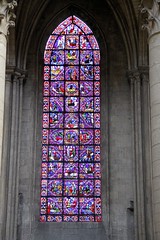
Rouen Cathedral was damaged but not destroyed during amongst others the Wars of Religion, the French Revolution, and the Second World War. As with any old house, maintenance work never ends and part of the cathedral is always covered by protective sheeting and scaffolding.
Many of the windows were blown out in 1944 during the Second World War. However, in 1939, on the initiative of Jean Lafond, almost all stained-glass windows in Rouen were removed from churches and historic buildings and kept safely until the end of the war. Rouen Cathedral thus has stained-glass windows dating from as far back as 1210.
Dimensions and Floor Plan of Rouen Cathedral
Rouen Cathedral is not the largest cathedral in France but it has the tallest steeple, the widest western façade, and the rest of the dimensions are impressive too. (North is to the left on the shown floor plan.)
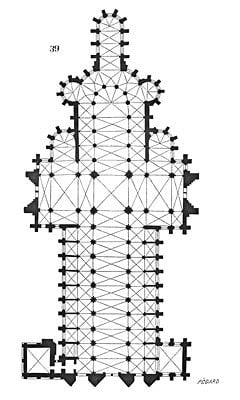

Exterior Measurements:
- Total length – 144 m
- Width of the western façade – 61.6 m
- Height of the steeple – 151 m (since 1876)
- Tour St Romain – 82 m
- Tour de Beurre – 75 m
Interior Measurements:
- Total length – 137 m
- Length of the nave – 60 m
- Height of the nave – 28 m
- Width of the nave including two side aisles – 24.2 m
- Width of the central aisle – 11.3 m
- Height of side aisles – 14 m
- Height of the lantern tower – 51 m
- Length of the choir – 34.30 m
- Width of the choir – 12.7 m
- Interior length of the transept – 54 m
See also the floor plan (description in French only).

Western Façade – a Monet Favorite
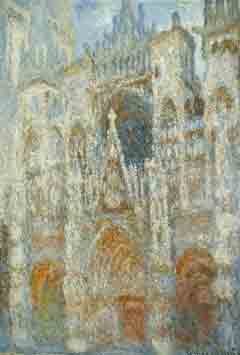
The western façade of Rouen Cathedral is the largest of any church in France. It was famously painted by Impressionist artist Claude Monet in a series of 28 paintings showing the façade at different times of the day. The paintings are now spread over the world with one in the local Fine Art Museum, five in the Musée d’Orsay , but all can be seen together, ordered by time of day, online on the Rouen parish website (French only) or on Wikipedia .
The oldest parts of the Gothic cathedral are the left tower and the two side portals on the Western façade – these date from the 12 th century. The tympana are from the 13 th century – the one on the left above the Portail St Jean shows the death of John the Baptist and on the Portail St Etienne the stoning of St Stephan (the first Christian martyr). The latticework window gallery and gables are Flamboyant Gothic from the late 14 th , early 15 th centuries.

The Early Gothic Tour St-Romain, the tower on the left (north), is the older with its base dating from the 12 th century. Its construction is generally seen as the start of the Gothic cathedral building project. The roof with golden suns, which was only added in the 15 th century, burned down in 1944 after a bombing raid by the US Air Force but was restored true to the original.

In 1507, the grander Flamboyant Gothic south tower was the last major part of the church to have been completed. It carries an octagonal crown and never had a steeple. It is known as the Tour de Beurre (Butter Tower), as it was believed that the construction was financed through indulgences paid by some of the rich, who did not give up eating butter during lent. (The magnificent Gothic cathedral in Bourges , France Centre, has a similar Butter Tower.)

The central doorway was only completed in the 16 th century, as the construction of the Butter Tower damaged the older structure. The tympanum here has the Tree of Jesse. It was destroyed by the Huguenots during the Wars of Religion but replaced in the early 17 th century and recently restored. The row of apostles are copies – the surviving statues can be seen close up in the ambulatory of the church (until they are moved eventually to a museum).
The Booksellers’ Portal
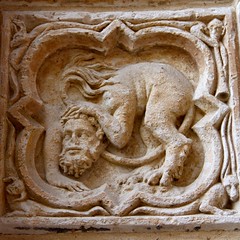
Rouen Cathedral’s transept can be entered from the north through the Portail des Libraries (Booksellers Portal). It is reached via a Flamboyant Gothic stone gateway and the Cours des Libraries, a courtyard traditionally used by booksellers. Note here the reliefs with scenes from the creation and early Genesis, as well as some fantasy animals, many combining body parts from humans.
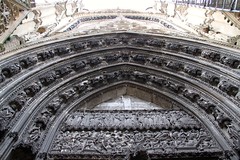
The late 13 th -century tympanum is of the Last Judgment – a scene often used at the central doorway of Gothic churches. The tympanum is due for a cleanup but the dead rising from the graves in the lower panel and being judged in the upper level are still easy to decipher. To the right, one of the sinners in a boiling cauldron is a bishop and next to it the devil grabs a sinner still clutching his bag of money.
Adjacent to the courtyard is the Bishop’s Palace (Archevêché) where Joan of Arc (Jeanne d’Arc) was tried and convicted in 1431. A plaque here reminds that she was rehabilitated in 1456, after Charles VII retook Rouen from the English. A chapel in the cathedral is dedicated to Joan of Arc but a large 20 th -century church at the other end of the old town is the main shrine to Jeanne d’Arc, who became the patron saint of France in 1920.
Southern Portal and Steeple of Rouen Cathedral
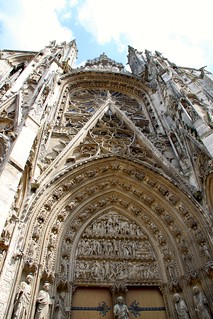
The southern doorway (Portail de la Calende) is from the 14 th century while the two towers on its side are a century older. The tympanum showing the passion and resurrection of Christ is considered one of the finest works from this period.
The south side of the cathedral affords some excellent views of the church towers too. The spire on the central lantern tower is at 151 m (496 ft) the tallest in France and the fourth tallest Christian church in the world.

The original square-base lantern tower from the 13 th century was raised in the 16 th century and capped by a wooden spire covered in lead. Although lightning struck the cathedral often, the spire brought down by a lightning bolt in 1822 stood for almost 300 years.
The current cast-iron spire of Rouen Cathedral was completed in 1876 and was for four years the tallest man-made structure in the world. The steeple is missing one of the four small green turrets – it fell through the roof during a storm on December 26, 1999. The damage can still be seen in the repaired vaults inside the choir – look up when standing near Rollo and Richard the Lion Heart’s tombs.
The Interior of Rouen Cathedral

The interior of Rouen Cathedral is High Gothic at its best. The nave soars four stories high and the church seems to stretch on forever. The Rouen Cathedral is third in length in France after the huge Reims and Amiens cathedrals .
The Nave of Rouen Cathedral
The 11-bay nave is early Gothic but many of the chapels and decorations were added in high Gothic. The well-lit nave is 28 m high with many of the clerestory windows clear. The two side aisles are half the height of the central aisle and lined with chapels.
Note the stained-glass windows in the chapels of St Sever and St Jean (north side). The upper sections are from 1210, the oldest in the cathedral, while the lower sections are 15 th century. The rose window in the west above the modern organ is Flamboyant Gothic.
Transept and the Lantern Tower

At the north end of the transept is the Escalier de la Librarie (Booksellers’ Stairway) – the lower flight is from the 15 th century while the upper flight was added in the 18 th century.
The lantern tower at the crossing rises 51 m (167 ft). One of the four huge pillars keeping the tower up was almost destroyed by an RAF bomb in 1944; its collapse could have brought the whole church down.
Of the south end is the Joan of Arc Chapel with modern glass – a large church in the opposite end of the old town is dedicated to France’s patron saint. The rest of the windows in the south transept is mostly from the Renaissance and tells the martyrdom of St Romain.
Choir and Ambulatory of Rouen Cathedral
The choir is 13 th century and shows how well Gothic architecture, compared to the earlier Romanesque, can give an impression of lightness and elegance while still keeping up the heavy vaulted roof.
In the ambulatory are several tombs with recumbent figures of Norman dukes. The statue of Rollo (c. 846 to c. 931 and first Viking duke of Normandy) is a copy and only his femur (thigh bone) is left in the tomb.

Only the heart of Richard the Lion Heart (1157-1199), king of England and 12 th duke of Normandy, is entombed here. His entrails are buried at Chalus-Chabrol where he died, while the rest of his body is buried at Fontevraud Abbey (near Tours on the Loire). At his feet lies a lion – not only a reference to his nickname but also a medieval symbol of resurrection.
Also in this area are the original statues of the prophets taken from the central doorway on the western façade – they will eventually be moved to a museum. Five of the stained-glass windows are from the 13 th century, many featuring strong Chartres blue and red pieces. The rest of the stained glass is mostly from the Renaissance.
The 14 th -century Lady’s (or Virgin’s) Chapel is 25 m long and usually not open to tourists. Most of the glass dates from the building period but much of the other decorations are two hundred years newer. On the left wall of the chapel is the tomb of Louis de Brézé. He was the seneschal of Normandy but is now better known for being the husband of Diane de Poitiers – she became the favorite mistress of Henri II after her husband’s death. (See Chenonceau for more on Diane, Henry, and Catherine de Medici – Henry’s formidable wife).

To the left of the chapel is the grave of Hugues d’Amiens (died 1164), Bishop of Rouen. His body was placed in a tomb from the 12 th century and is believed to have the oldest recumbent tomb statue ( gisant ) in France.
The Romanesque crypt was part of the 11 th -century Romanesque cathedral destroyed by fire in 1200. It can only be seen on the guided tour of the cathedral.
Opening Hours of Rouen Cathedral
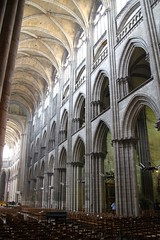
Rouen Cathedral is still a working Roman Catholic church and thus has fairly long opening hours and free admission. Note the closure on Monday mornings and also lunch hour closings during the colder months.
Rouen Cathedral’s opening hours are:
- Monday 2 to 6 pm
- Tuesday to Saturday – 9 am to 7 pm
- Sunday 8 am to 6 pm
From November to April, the church closes at 6 pm and is closed over lunch from noon to 2 pm.
Parts of the church – usually the choir area or Virgin’s Chapel – are closed during services. Sometimes one of the ambulatory entrances remains open.
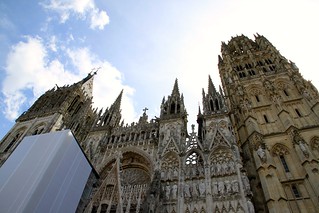
In summer, late June to mid-September, a free light show is projected onto the western façade – usually showing Monet-like colors and Impressionist dots. As it grows dark late in summer, the half-hour show starts after 10 pm.
Rouen Cathedral is in a part of France with many large churches – only a few blocks away is the Church of St Ouen , another Gothic wonder even larger than the cathedral. A short drive to the west of Rouen are the Romanesque churches of St Martin de Boscherville and the marvelous ruins at Jumièges . The largest Gothic church in France is not far away either in Amiens .
For more on Rouen Cathedral see also:
- Photos of Rouen Cathedral on Flickr .
- Parish of Notre Dame de Rouen – a full description of the church in French including photos of the parts of the cathedral generally not seen by visitors.
- Various parts of the cathedral seen in 360° photos .

About the author:
Henk Bekker
Henk Bekker is a freelance travel writer with over 20 years of experience writing online. He is particularly interested in history, art, and culture. He has lived most of his adult life in Germany, Switzerland, and Denmark. In addition to European-Traveler.com , he also owns a travel website on the Lake Geneva region of Switzerland and maintains statistical websites on car sales and classic car auction prices . Henk holds an MBA from Edinburgh Business School and an MSc in Development Finance from the University of London.

Home » France » Visit Rouen Cathedral – Gothic at its Best in Normandy
To provide the best experiences, we and our partners use technologies like cookies to store and/or access device information. Consenting to these technologies will allow us and our partners to process personal data such as browsing behavior or unique IDs on this site and show (non-) personalized ads. Not consenting or withdrawing consent, may adversely affect certain features and functions.
Click below to consent to the above or make granular choices. Your choices will be applied to this site only. You can change your settings at any time, including withdrawing your consent, by using the toggles on the Cookie Policy, or by clicking on the manage consent button at the bottom of the screen.
- Sites and Monuments in Paris
- Sites and Monuments in France
- Things to do in Paris
- Things to do in France
- ACCOMMODATION
- RENTING A CAR
- CHEF SERVICE
- CONCIERGERIE SERVICES
- TRAVEL TIPS
- TRAVEL LUGGAGE
- Arrondissements
- Monuments & Landmarks
- Secret & Offbeat Paris
- More about Paris...
- Île de France
- More Regions of France...
- Aix-en-Provence
- More Cities...
- Castles and Palaces
- Cathedrals and Churches
- Gardens and Parks
- World Heritage Sites
- Villages of France
- Autumn / Fall
- Mardi-Gras / Carnival
- April Fools' Day
- Bastille Day
- All Saints' Day
- More Holidays and Celebrations...
- National Anthem
- Gallic Rooster
- National Day
- Motto of France
- Motto of Paris
- Coat of Arms
- French President
- Le Croissant
- French Cheese
- French Wines
- Christmas Food and Recipes
- French Nursery Rhymes
- France geography
- FUN QUIZZES
- MOVIES AND MUSIC
- FRENCH LANGUAGE
- BOOKS BY FRENCH MOMENTS
- BOOK RECOMMENDATIONS
- The Secrets of the Eiffel Tower
- The Gems of Paris
- Office desks and chairs
- Travel suitcases
- LEARN FRENCH WITH PIERRE
- THE STORY SO FAR
- WORK WITH US
- THE NEWSLETTER
- HOW TO SUPPORT US
- PHOTO USAGE POLICY
Tour Saint-Romain, Rouen Cathedral
Last Updated: 15 April 2020
Rouen ’s most prestigious monument, the lofty and imposing cathedral, is one of the most exquisite pieces of pure Flamboyant work existing. Tour Saint-Romain is dedicated to St. Romain. It is one of the three mighty towers that make the cathedral of Rouen one of the country’s most stunning sanctuaries.
Tour Saint-Romain: a stunning Gothic tower
On the northern side of the West front of the cathedral of Rouen lies the mighty Tour Saint Romain , four centuries older than its counterpart, the Tour de Beurre.
Work on the tower started in 1145 , so it is the oldest part of the Gothic construction. Its last storey, in Flamboyant style, clashes with the rest of the more sober building. The Saint Romain tower burnt down on the 1st June 1944, after Allied bombing the day before. The bells melted inside and only the walls were left standing.
Its unusual axe-like roof, covered with slates and decorated with gilded images of a sun, has been reconstructed only recently and inaugurated at Easter 1987.
The tower is best seen from the Place de la Cathedral and the streets of rue Saint-Romain and rue du Gros-Horloge. It is 82 metre tall.
My book recommendation!
Its name? Simply:
Gothic: Architecture, Sculpture, Painting b y Rolf Toman, Publisher: Ullmann
This book has been for me a great resource that helped me better understand the Gothic movement in art from the 12th century to the Renaissance. An architectural style that first originated from France and spread all over Europe.
Over 500 pages it focuses on the development of Gothic architecture with many illustrations and photographs, but not only. I’ve also found interesting the in-depth discussion of the most diverse art forms, including painting, sculpture, metalwork and even book illumination! It also includes specific coverage of the Cathars’ Heresy and the Papal Palace in Avignon. And, of course, it mentions the cathedral of Notre-Dame de Rouen!
This is definitely the book I recommend if – like me – you love everything about Gothic such as churches, gargoyles, stained glass, flying buttresses and so much more.
Order it online!
Interior of Tour Saint-Romain
The ground floor of the Tour Saint-Romain is occupied by a lower room which houses the baptistery.
The second floor is a large room with a double level of windows. Above it is the belfry floor which houses the largest bell of the cathedral, the Jeanne d’Arc.
The Legend of St. Romain and the Gargouille
The tower takes its name from Rouen’s most venerated bishop: St. Romain (or Romanus). According to tradition, the patron saint lived under King Dagobert I and is remembered as a protector of the city. There were wild swamps on the left bank of the Seine, opposite the old town, where a terrifying dragon lived who “ devoured and destroyed people and beasts of the field ”. The people of Rouen named it “ Gargouille ”.
Joined by a man condemned to death, having nothing to lose, they crossed the Seine and chased the dragon. When the Patron Saint caught it, Saint Romain drew the sign of the cross on the monster. Then he put his cape around it and dragged the beast to the parvis of the cathedral where the Gargouille was burnt to death. After that, it was a local custom for the bishop of Rouen, once a year, to grant one prisoner who had been condemned to death, his freedom (a custom which lasted until 1790). Needless to say, this legend draws similarities with the Graouilly of Metz .
For more information, visit the Rouen Tourist Board website .
Check out our curated magazine on Flipboard for exclusive stories & insights on France!
About the author
Pierre is a French/Australian who is passionate about France and its culture. He grew up in France and Germany and has also lived in Australia and England. He has a background teaching French, Economics and Current Affairs, and holds a Master of Translating and Interpreting English-French with the degree of Master of International Relations, and a degree of Economics and Management. Pierre is the author of Discovery Courses and books about France.
Like it? Leave a comment!
Your email address will not be published. Required fields are marked
Name * * * * * * * * * *
E-mail * * * * * * * * * *
Website [optional]
Save my name, email and website in the browser for my next comment.
This site uses Akismet to reduce spam. Learn how your comment data is processed .
Transparency: Some blog posts and pages may contain affiliate or sponsored links. If you are planning a trip, the use of these links helps us to run the site. There is no additional cost to you. All you have to do is click on the link and any booking you make is automatically tracked. Thank you for your support!
Escape to France with every email! Get insider insights, travel guides, cultural gems delivered and exclusive offers to your inbox twice a week. Your journey to Paris and France begins when you sign up!
SUBSCRIBE TO THE NEWSLETTER AND GET THE FREE EBOOK
24 PLACES TO SEE IN FRANCE
- Loire Valley
- South of France
- France Off the Beaten Path
- Non-Touristy Paris
- Arles & The Camargue
- Haute-Marne
- Loire: The Department
- Nancy Art Nouveau
- 9 Sensational Road Trips
- How to Plan Your Route
- 10 Days: South of France
- 7 Days: Basque Country
- 5 Days: Lake Geneva & Alps
- France's Regions
- France's Departments
- France's Cities
- Best Seasons
- Official Holidays
- Essential Planning Tips
- Paris Hotels with Spa
- Paris Hotels with Balconies
- Cool Paris Hotels
- Driving in France
- Taking the Train
- Renting a Car in France
- How to Shop in France
- Le Petit Shop
- Christmas Gifts
- Things to Do in Lyon
- What Is Lyon Famous for?
- The Food Capital of the World
- The Lyon Murals
- Public Transportation in Lyon
- Best of France Know-How
- Most Beautiful Villages of France
- Flavigny-sur-Ozerain
- Best Landmarks
- Best Flea Markets
- Best Books About France
- Best Christmas Markets
- France's Favorite Foods
- A Typical French Breakfast
- Apero Time!
- Weird French Foods
- Let Them Eat Baguette
- French Pastry Desserts
- The Bouillons of Paris
- La Vache Qui Rit
- French Christmas Meals
- Did You Say Escargot?
- French Revolution Tours
- Ghost Tours
- Paris Food Tours
- Stereotypes and Myths
- Facts about Ze French
- La Loire: What's in a Name?
- France's Backstory
- France's Roman Ruins
- Chenonceau Castle
- La Belle Epoque
- Most Haunted Places in Paris
- Dark Tourism in Paris
- France's Abandoned Places
- Paris Catacombs
- They Built a Wall
- Legends of the Luberon
- Lyon's Secret Passages
- Small & Odd
- Burgundian Life, Dijon
- Counterfeit Museum, Paris
- France's List of Lists
- Food & Wine Brotherhoods
- Vercingetorix, King of Gauls
- The Salacious Count Bussy-Rabutin
- Napoleon Bonaparte
- General Charles de Gaulle
- Breakfast in French?
- Bathroom in French?
- Free Resources
- Most Popular Posts
- Beyond the Baguette Newsletter
Unsure about your French table manners? Click Here to download > > How to avoid these 10 food etiquette mistakes !
Follow me on
- Destinations
- Cathédrale de Rouen
7 Thematic Ways to Explore Rouen Cathedral, A Gothic Masterpiece
Published 31 March 2024 by Leyla Alyanak — Parisian by birth, Lyonnaise by adoption, historian by passion
Rouen is the capital of Normandy, but its cathedral is, in a way, the “capital” of Rouen. It is Rouen's most prestigious monument and deserves to be explored in detail. You can do it any way you like but I've divided the visit into seven topics, or themes, through which to discover this amazing building.
Even if you don’t care about architectural style, if the Middle Ages make you yawn, or if you think Gothic means wearing black eye makeup, Rouen Cathedral will make you sit up and take notice. This may be the beginning of your love affair with these buildings.
I only say this because it’s what happened to me.
I’ve never been a huge fan of religious architecture but when I first set eyes on the façade of Notre-Dame de Rouen, I almost lost the ability to breathe for a second. Exploring this magnificent building is one of the unmissable and most rewarding things to do in Rouen .
NOTE: Pages on this site may contain affiliate links, which bring in a small commission at no cost to you.
7 Approaches to the Cathedral of Rouen
1. Through history and resilience
2. through artistic inspiration, 3. through architectural evolution, 4. through its components, 5. through its role as an illustrious necropolis, 6. through superlatives, 7. through religious significance.
Taking in the filigree that decorates this cathedral's exterior is like trying to deconstruct a piece of lace: intricate, delicate, overwhelming, and ultimately impossible.
The design, the balance, the exquisite carving – it’s as though someone designed the most complicated building possible, and then doubled the work.
To build this from scratch might have been impossible, but by adding layer upon layer, this beautiful gem finally emerged.
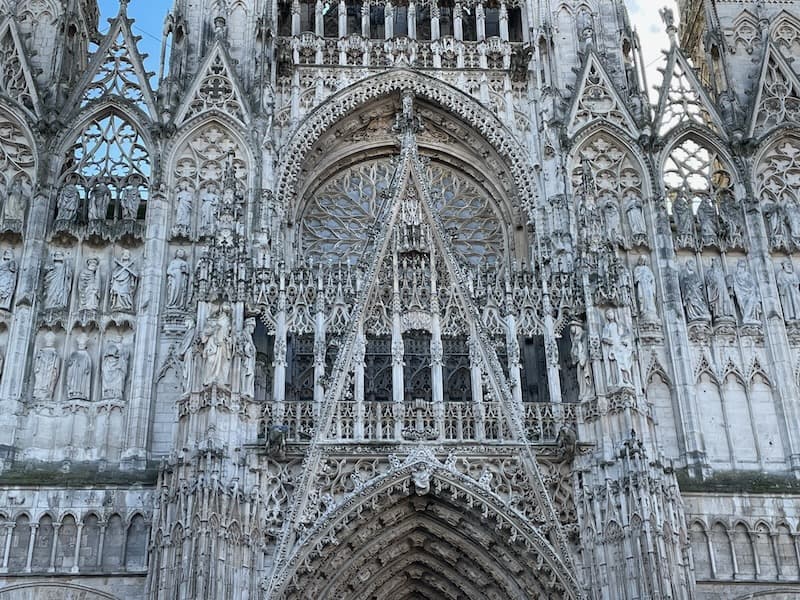
How to explore the Cathedral of Rouen
The cathedral is Rouen’s most prestigious building, reflecting more than 1000 years of tumultuous history, a muse for artists and a magnet for visitors.
You can approach in a variety of ways, depending on your interests, and I’ve applied seven different themes, or prisms, through which you can explore this spectacular structure. Whichever you choose, you will probably not walk away untouched.
If a building were to receive a prize for survival, this cathedral just might land in first place. Like the proverbial phoenix, it has been destroyed and reborn countless times.
- 9th century: this was the first destruction, courtesy of Viking raids, which left the original church damaged and in need of rebuilding.
- Reconstruction in the Romanesque style would begin in the 11th century, just a few years before the Norman invasion of England (so well depicted in the extraordinary Bayeux tapestry a two-hour train ride away). But in 1200, a major fire would devastate the cathedral and repairs would take nearly half a century.
- In 1562, as the Wars of Religion swept Europe, the Rouen Cathedral was ransacked by Huguenots. They damaged its façade, destroyed its statues, and generally vented their anti-Catholic sentiments.
- Then the hugely anti-clerical French Revolution came, and the cathedral, its religious function removed, turned into a “temple of reason”, as many churches were.
- 1822: Its original spire was made of wood and was destroyed by lightning, so a new one was built, with the more resilient and modern cast iron replacing the fire-prone wood.
- 1944: The Allies, fighting to displace German occupying forces during World War II, bombed Rouen, inflicting significant damages and destroying a large part of the cathedral, which would take a dozen years to repair. In fact, after the bombs fell it was nicknamed “Our Lady of the 7 Shells”.
- 1999: A violent storm damaged the cathedral yet again, kickstarting another round of repairs.
It never ends! But if nothing else, all these challenges underscore the cathedral’s immense resilience and the ongoing commitment of the Rouennais to rebuild and preserve their most beloved monument.
The cathedral has inspired one of the most cherished artists of recent times, Impressionist Claude Monet, who painted its western façade no fewer than 30 times, cementing the reputation of the city of Rouen as “ capital of Impressionism ”.
Because of its intricacy, each tiny patch of the cathedral's face absorbed light differently, depending on the time of day, almost driving Monet mad with the impossibility of capturing it fully. And so he kept trying. Below are three of his works.
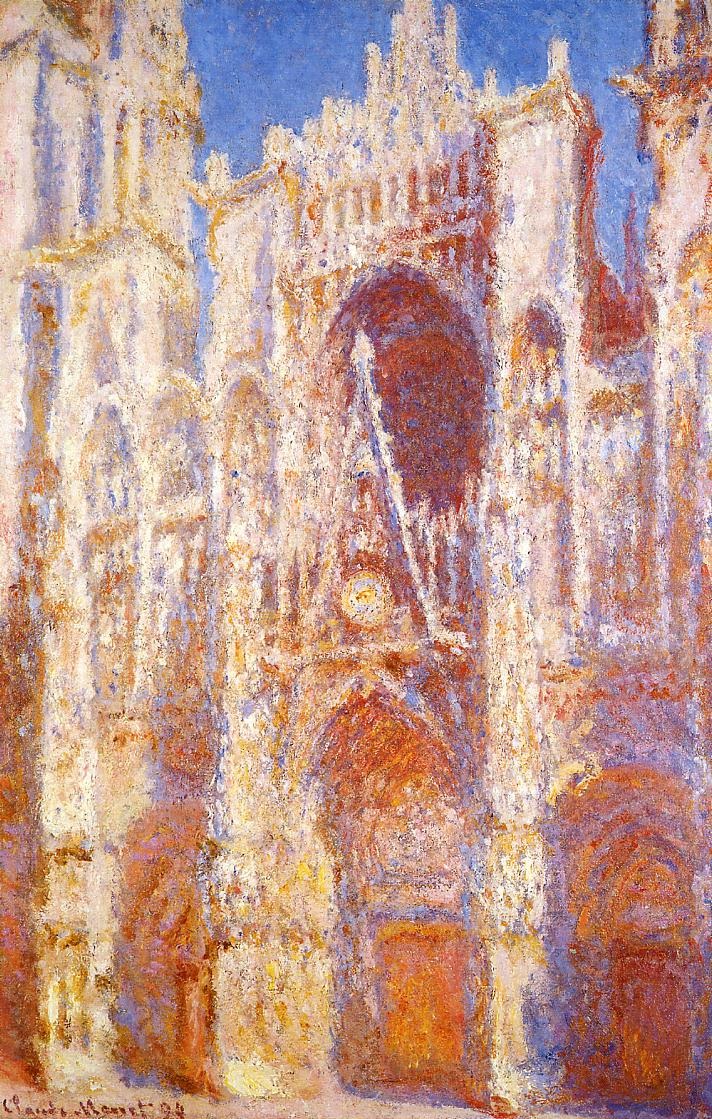
Camille Pissarro would also find inspiration here, as would Roy Lichtenstein and plenty of others.
The cathedral would also inspire writers, like Gustave Flaubert, a native of the city, and Victor Hugo, both of whom would often use the cathedral as a backdrop for their scenes.
CURIOUS ABOUT NORMANDY?
Here are a few trustworthy guidebooks to take along on your trip:
- Rick Steves’s Snapshot Normandy
- Moon Normandy and Brittany (With Mont-Saint-Michel)
- Michelin Green Guide Normandy (2020)
If there’s one thing the cathedral is famous for, it’s the different styles it has worn over the centuries.
While there are no visible vestiges of the Gallo-Roman church that once stood here, a piece of wall from the 12th century remains from the Romanesque cathedral, visible on the left if you’re facing the main western entrance.
The original Romanesque cathedral, commissioned by Archbishop Robert the Dane around 1030, featured most of the elements we have today and would set the stage for the cathedral's later developments.
The Gothic movement would begin with the rebuilding of the cathedral after the dreadful 1200 fire. We would see the arrival of those oh-so-Gothic features, the pointed arches and flying buttresses that let in more light and allowed for higher ceilings.
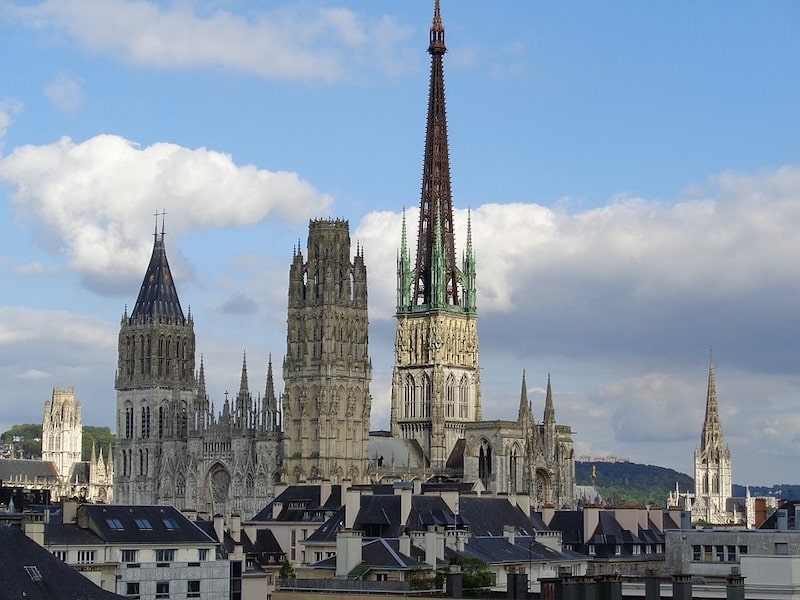
The Gothic structure was built on top of its Romanesque predecessor. In other words, the cathedral was built from the outside in – first the façade and then, slowly, the interior, with builders dismantling the older structure progressively as they advanced inward.
Step by step, the building would grow. During the 15th century, an additional storey was added to the first tower (tour Saint-Romain) and a second, the so-called Butter Tower, or Tour de Beurre, was built. But it would fissure, weakening the entire structure, calling for reinforcement work.
WHY CALL IT THE BUTTER TOWER?
For one of two reasons. The first is because of the stone’s yellowish color, which stands out against the white stone used elsewhere for the cathedral. The other, and more plausible one according to historians, is that the tower was financed by donations made to the church for forgiveness for having eaten butter during Lent.
The third cathedral tower, the “lantern tower”, was completed in the early 16th century and is dizzying in height, soaring upwards for 54m/177ft before the spire even begins. Typical of Gothic architecture, it was designeçd to draw light into the heart of the church and was a remarkable engineering feat at the time.
Its construction and that of the final façades would culminate in the cathedral we have today.
This is a brief overview, of course, and there’s plenty more to learn about the cathedral’s architecture .
While the cathedral as a whole is superb, I’d like to draw your attention to some of its components.
The stained-glass windows
Take your time admiring the windows, which range in date from the 13th to the 20th centuries, allowing the light to enter and to play upon the walls and statues. Some of the windows were offered by guilds during the 13th century, such as the one by the city’s fishmongers.
One of the most beautiful is the rose window, although it was shattered during a 17th century hurricane and eventually restored thrugh a donation by Louis XIV .
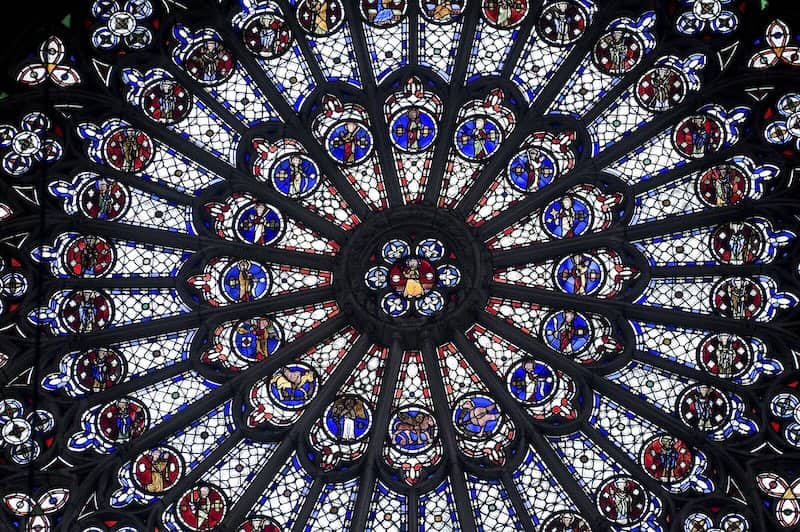
The building stone
Two types of stone were used in building. The first was sturdy white stone from the Seine valley. The later use of yellow stone available closer to Paris may have been the result of scarcity of the white stone; the yellow stone was also easier to sculpt.
The cast iron spire replaced the wooden one after lightning struck it in 1822, and it has again been renovated, this time painted in deep turquoise rather than the original brown. The arrow weighs 9000 tons: 8000 tons of stone and one ton of iron.
The chapels
The cathedral contains numerous small chapels built to venerate saints but also to increase the cathedral’s size.
The main one is dedicated to the Virgin Mary, the Chapelle de la Vierge, and is home to several important tombs. I was particularly intrigued to learn it included that of Louis de Brézé, whose death resulted in the lengthy relationship between his widow, Diane de Poitiers, and King Henri II (the castle of Chenonceau would be the scene of some of their amours).
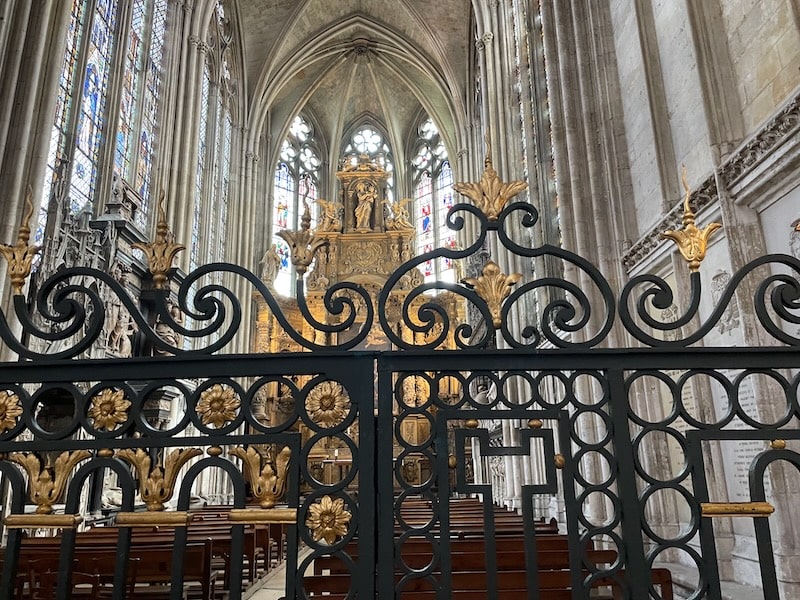
Fittingly for Rouen, one of the chapels is dedicated to Joan of Arc , her modernist stained glass windows telling the story of her life. At the bottom is the inscription: “From the English in homage”.
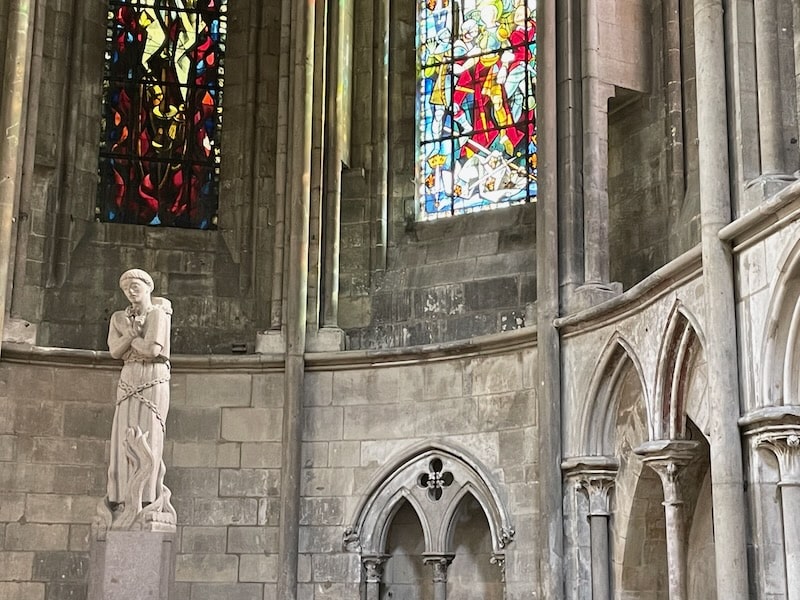
The stairway
A stunning Gothic stairway was built to reach the library during the 15th century, one of the first Norman examples of a straight stairway (most had been spiral until then).
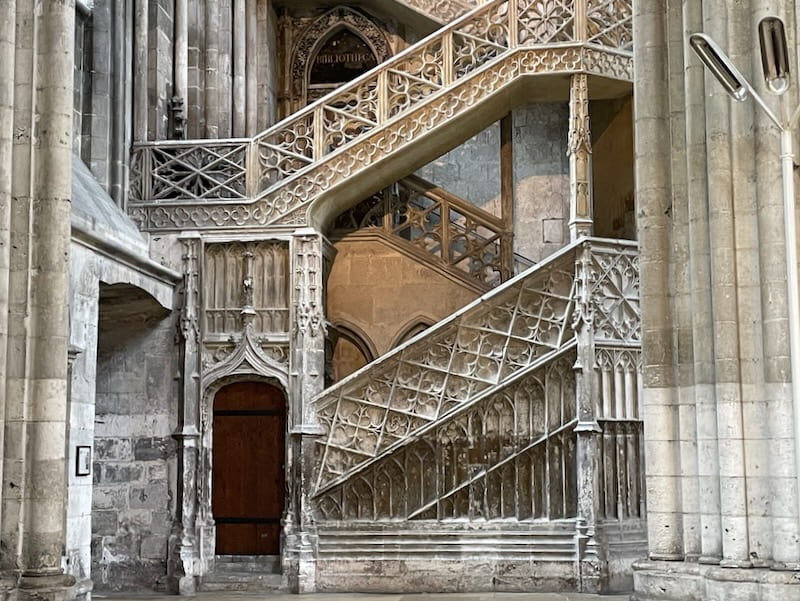
The statues
Time, weather, war, all these have darkened and helped erode some of the cathedral’s works. The last time major restoration work took place, a number of the façade’s statues were brought indoors and replaced by copies.
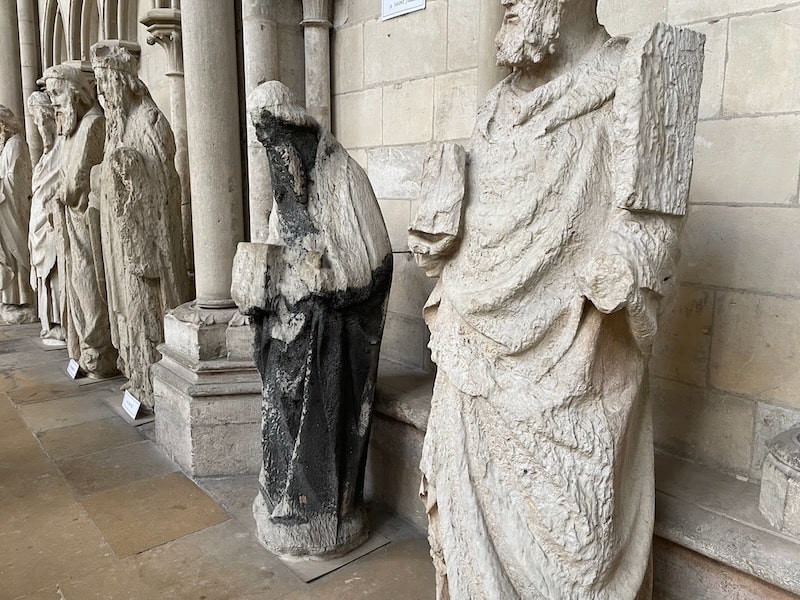
A bit like the Pantheon or Saint-Denis Basilica in Paris, famous personages are buried here and those with an interest in history come to pay their respects.
The most famous, of course, is the near-mythical Richard the Lionheart , whose heart was buried here and whose “gisant”, or recumbent tomb effigy, is clearly visible.
When he died, his body was split in three, with his entrails buried on the site of his death in battle at Châlus in eastern Aquitaine, his body at the Plantagenet necropolis of Fontevraud Abbey (along with his parents, Henry II of England and Eleonor of Aquitaine), and his heart in Rouen, as per his wishes.
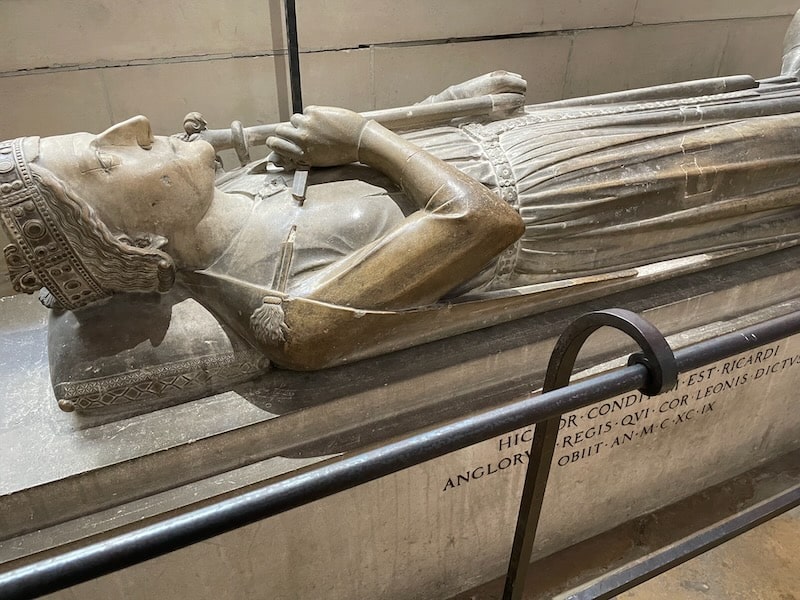
There are plenty of other recumbent statues buried here include Richard’s brother, Henry; Rollo, first Duke of Normandy; and Rollo’s son William.
We like our “mosts” and our “bests” and Rouen’s cathedral doesn’t lack any of these.
- It is the tallest cathedral in France and boasts the country's tallest spire, at 151m/495ft (for a time, it was the world's tallest building).
- It also has France’s second-largest carillion after Chambéry, and one of the first organs to be seen in a Western church.
- And it has the widest façade in France, 61m/200ft (the façade of Notre-Dame in Paris “only” measures 44m/144ft).
- At 137m/449ft, it is slightly longer than Notre-Dame in Paris, but only by 10m/33ft. Still.
➽ If you're visiting in summer, don't miss the Cathedral's fabulous sound and light show !
Today's imposing cathedral is a very early church. It was appointed seat of the bishop of Rouen in the 3rd century, as early Christianity was spreading and is Normandy’s oldest Christian monument, becoming the See of the Archbishop of Rouen in the 8th century, nearly 1300 years ago.
Nothing has interrupted its religious vocation, with the exception of a few years during the French Revolution.
With Rouen was established as Normandy’s capital, the cathedral slowly became a focal point of Norman spirituality and power. The first Norman duke, Rollo, would be baptized here, sealing the integration of Vikings into Christian and Frankish society.
Before you go…
How about a book recommendation?
You may recall years ago having come across, as a child, a copy of Cathedral: The Story of its Construction by David Macauley, an intriguing black-and-white book filled with architectural drawings of a fictitious cathedral’s interior. That book has now been updated and republished in full color, and while it’s designed for children, it’s also perfect for those of us who need an architectural primer to help us tell a nave from a transept.
The Rouen Cathedral is a living monument of both Christianity and France’s heritage, destroyed and rebuilt, never static and ever-changing, and always enduring in spirit.
Did you enjoy this article? I'd love if you shared it!

Bonjour! I’m Leyla! I was born in Paris and now live in the bucolic mountain foothills of Eastern France between Lyon and Annecy.
I'm rediscovering my own back yard after years of living abroad in Canada, Spain and Switzerland as a journalist and a diplomat - and I'm loving every minute.
Passionate about history and culture, I’ve created Offbeat France to seek out my country’s mysteries and legends, less-traveled destinations, along with plenty of food stops and many castles - I am French, after all!
What's New!
Chateau D'Anet: The Love Nest Of Henri II And Diane
Jun 15, 24 02:17 PM
Visiting The D Day Beaches? This Is The Only Guide You'll Need
May 21, 24 01:06 AM
3 Fascinating Castles Near Paris That Are Way Under The Radar
May 19, 24 07:23 AM
La Maison Picassiette In Chartres: The House Of A Million Pieces
May 12, 24 12:49 PM
How To Get To Mont Saint-Michel: The Ultimate Hassle-Free Guide
May 02, 24 04:09 PM
© Copyright 2024 OffbeatFrance.com | All Rights Reserved | Privacy Policy & Disclaimer | Contact Me | ABOUT
As an Amazon Associate offbeatfrance.com earns from qualifying purchases
- Collectibles
Cathédrale Notre-Dame de Rouen: A Majestic Journey Through Time
- by history tools
- May 27, 2024
Nestled in the heart of Rouen, Normandy, the Cathédrale Notre-Dame stands as a testament to the region‘s rich history and architectural prowess. This Gothic masterpiece has witnessed nearly a millennium of triumph and tragedy, from the height of the Plantagenet dynasty to the destruction of World War II. Join us as we embark on a fascinating journey through the cathedral‘s past and present, uncovering the stories etched in its soaring spires and sacred stones.
Building a Legacy: The Rise of Rouen Cathedral
The story of Rouen Cathedral begins in the 4th century, when the first Christian place of worship was established on the site. However, the current cathedral traces its roots back to the 12th century, when construction began under the guidance of Archbishop Hugues d‘Amiens. The earliest parts of the cathedral, including the crypt and the lower levels of the Tour Saint-Romain, date from this period.
Over the centuries, the cathedral underwent numerous expansions and renovations, reflecting the evolving tastes and techniques of Gothic architecture. The 13th century saw the addition of the nave and transept in the High Gothic style, characterized by its pointed arches, ribbed vaults, and intricate tracery.
The western facade, perhaps the cathedral‘s most recognizable feature, showcases the transition from Early to High Gothic style. The Tour Saint-Romain on the right, begun in the 12th century, exhibits the simpler, more austere Early Gothic aesthetic. In contrast, the Tour de Beurre on the left, added in the 15th century, boasts the more ornate and decorative elements typical of the Flamboyant Gothic period.
Art historian Emil Kaufmann describes the facade as "a masterpiece of the Late Gothic style, with its lace-like tracery and profusion of ornament." The juxtaposition of these two towers creates a stunning visual representation of the cathedral‘s architectural evolution.
Royalty and Remembrance: The Tombs of the Mighty
Step inside the cathedral, and you‘ll find yourself in the presence of some of the most influential figures in Norman and English history. The Chapelle de la Vierge, situated behind the high altar, serves as the final resting place for several notable individuals:
Richard the Lionheart (1157-1199) : The legendary King of England, known for his bravery and military prowess, requested that his heart be buried in Rouen. As chronicler Roger of Howden wrote, "He gave his body to the Abbey of Fontevrault, his heart to the Cathedral of Rouen, and his entrails to the town of Châlus."
Rollo (c. 846-c. 928) : The Viking warrior who founded the Duchy of Normandy in 911 after signing the Treaty of Saint-Clair-sur-Epte with French King Charles III. His remains were transferred to the cathedral in 1063, cementing his status as a key figure in Norman history.
John, Duke of Bedford (1389-1435) : The English regent of France during the Hundred Years‘ War, known for his strategic military campaigns and his patronage of the arts. His tomb in the cathedral reflects his significant role in the conflict that shaped the destinies of England and France.
The presence of these illustrious figures underscores the cathedral‘s importance not only as a religious center but also as a symbol of political power and cultural identity. As historian David Bates notes, "The cathedral was the spiritual and ceremonial heart of the Norman duchy, and the burial of its rulers there was a powerful statement of their authority and legitimacy."
War and Resurrection: The Cathedral in Conflict
Throughout its long history, Rouen Cathedral has endured its share of hardships, perhaps none more devastating than the destruction wrought by World War II. In 1940, a fire damaged part of the cathedral‘s structure, but the worst was yet to come.
On June 1, 1944, Allied bombing raids aimed at German forces in Rouen inadvertently struck the cathedral, causing catastrophic damage. The nave collapsed, and the intense heat from the ensuing fires weakened the towers and spire. Contemporary accounts paint a grim picture of the aftermath:
"The cathedral was a scene of utter devastation. The nave was a heap of rubble, and the towers stood like skeletal fingers pointing to the sky. It seemed impossible that such a magnificent building could ever be restored to its former glory." – Pierre Chirol, eyewitness
However, in the face of this destruction, the people of Rouen rallied to save their beloved cathedral. Extensive restoration work began in the 1950s, led by chief architect Albert Chauvel. Over the next few decades, skilled craftsmen and dedicated conservationists worked tirelessly to repair the damage and fortify the weakened structure.
The restoration of Rouen Cathedral stands as a testament to the resilience and determination of the local community, as well as the enduring power of this architectural marvel to inspire and unite people across generations.
A Gothic Symphony: Rouen Cathedral in Context
To fully appreciate the significance of Rouen Cathedral, it is essential to understand its place within the broader context of Gothic architecture in Europe. The cathedral shares many features with other renowned Gothic edifices, such as Notre-Dame de Paris and Chartres Cathedral, including its pointed arches, ribbed vaults, and expansive stained glass windows.
However, Rouen Cathedral also boasts several unique characteristics that set it apart from its counterparts. One such feature is the Butter Tower, so named because its construction was funded by donations from the sale of butter during Lent. This ornate tower, with its intricate tracery and delicate carvings, showcases the Flamboyant Gothic style at its finest.
Another distinctive element is the Booksellers‘ Stairway, a 15th-century spiral staircase that once led to the cathedral library. The staircase, adorned with exquisite stone carvings depicting scenes from the Bible, is a testament to the cathedral‘s role as a center of learning and intellectual pursuits.
Art historian Paul Williamson sums up the cathedral‘s architectural significance: "Rouen Cathedral is a magnificent example of the evolution of Gothic architecture over several centuries. Its unique blend of styles, from the Early Gothic simplicity of the Tour Saint-Romain to the Flamboyant exuberance of the Butter Tower, makes it a true gem in the crown of European cathedrals."
Experiencing the Timeless Beauty of Rouen Cathedral
For those fortunate enough to visit Rouen Cathedral today, the experience is one of awe and wonder. The cathedral‘s majestic facade, rising high above the surrounding buildings, is a sight to behold. The intricate stone carvings, soaring spires, and stunning stained glass windows create a sense of reverence and timelessness.
Visitors can explore the cathedral‘s rich history and artistic treasures through guided tours, audio guides, and informative displays. The crypt, dating back to the 11th century, offers a glimpse into the earliest days of the cathedral‘s construction. The treasury houses a collection of priceless religious artifacts, including reliquaries, vestments, and manuscripts.
One of the most captivating experiences at Rouen Cathedral is the nightly light and sound show, known as the "Cathedral of Lights." During the summer months, the western facade is illuminated with a mesmerizing display of colors and images, accompanied by music and narration. This spectacle brings the cathedral‘s history and beauty to life in a truly unforgettable way.
As you stand before the Cathédrale Notre-Dame de Rouen, take a moment to reflect on the countless generations who have marveled at its grandeur, sought solace within its walls, and contributed to its enduring legacy. This magnificent cathedral is more than just a building; it is a living testament to the power of faith, art, and human ingenuity to transcend time and inspire wonder.
Related posts:
- Unveiling the Grandeur: Exploring the Carthage Roman Theatre and Odeon
- Unveiling the Timeless Allure of Castle Ward: A Historian‘s Perspective
- Chateau de Beauville: A Timeless Treasure in the Heart of France
- Christ Church, Oxford: A Timeless Monument to Academia and History
- Unveiling the Secrets of Clifton Rocks Railway: A Historian‘s Perspective
- Covent Garden: A Fascinating Journey Through Time
- The Enchanting Tale of Devil‘s Bridge: A Welsh Landmark Steeped in Legend
- The Dubrovnik City Walls: A Testament to the Pearl of the Adriatic

Rouen, Cathédrale Notre-Dame

The Roman city, Rotomagus, on the right bank of the Seine, retained its prosperity and size (100 hectaires) even in the Late Empire when it was fortified under the Emperor Gratien. Urban growth in the 11-12thth centuries led to the inclusion of the bourg of S-Ouen within the new wall. Of the cathedral rebuilt under Robert I towards the year 1000 and destroyed in a fire in 1200, only the crypt remains. After 1204 Rouen became a center of royal power: Philip Augustus built an enormous castle on the nearby hill of Bouvreuil; the donjon, much restored, still survives. By the thirteenth century the city population numbered around 40,000.
Begun ca. 1190
A basilica with an aisled nave of 11 bays with lateral chapels added to the outer envelope. The body of the church is intersected by a deeply-projecting transept with deep apsidal chapels. East of the crossing there is a long (5-bay) chevet with a 5-segment ambulatory and three radiating chapels -- the central one, rebuilt.
In the nave there is a four-story elevation of arcade, false gallery (ie without a floor), triforium and clerestory, while the later chevet has three stories.: a tall arcade on cyldindrical columns, a dark triforium like Soissons or Chartres Cathedra and a clerestory.
The fabric of Rouen Cathedral embodies construction from five main periods. 1. The Tour Saint Romain, to the north of the western frontispiece, was built c.1140-50, and it is clear that important construction work continued in the second part of the 12th century. 2. c1185 Bishop Gautier le Magnifique began the reconstruction of the nave.; the old transept and chevet were retained. 3. On Easter day, 1200 a fire badly damaged the cathedral. Repairs began soon afterwards, under the direction of Master Jean d'Andeli: the nave was conserved, work continuing on the upper parts, and construction advanced into the transept, continuing into the choir by around 1220. There was a consecration (Archbishop Pierre de Colmieu) in 1237. 4. Following soon after the addition of nave chapels (1265-1275), in the last decades of the thirteenth century new transept façades were built. Work on the north transept (Portail des Libraires) was begun by Master Jean Davi c1270-1280; the south transept (Portail des Calendes) followed soon afterwards. Work seems to have been financed partly by a wealthy member of the bourgeois from Harfleur, Jean Gorren. The axial chapel of the chevet was extended after 1302 at the request of Archbishop Guillaume de Flavacourt, who provided the land. The chapel was intended for the burial of prelates. 5. Late Gothic work of refurbishing or embellishment includes the reworking of the nave clerestory under Master Jean Perier (1362-1368) who also began to add a screen of tracery to the western frontispiece. Work continued under Jean de Bayeux (1388-1398) and Jenson Salvart (1398-1447) who also transformed the choir clerestory windows. The top of the Tour Saint Romain was built by Guillaume Pontifs between 1468-1478. In 1485 the foundation stone of the new south-west Tour de Beurre was laid by Archbishop Robert de Croimare. Work on the tower, troubled with structural problems dragged on until the 1520s; more additions were made in the central area of the western frontispiece. The central steeple was destroyed by fire in 1822 and was replaced in cast iron by the architect Alavoine. Very severe damage resulted from Allied bombing in 1944; on June 1 the city burned and much of the cathedral roof was destroyed.
The four-storey galleried elevation of the nave looks both to Norman traditions (S-Etienne of Caen b-1099) but also to more recent buildings in the Ile-de-France (Senlis Cathedral b-1050, Notre-Dame of Paris b-1164); the builders of the transept and chevet, however, constructed after the Conquest, refer to models in the Soissonais and Ile-de-France. The forms of the chevet provide an important model for Norman churches of the 13th century. The nave begins when the Plantagenets are still in control of this area. King John gave 2,000 livres to the Cathedral for rebuilding. Richard the Lionheart's heart is buried in the church. It would have been a necropolis for the Plantagenets In 1204 Chateau Galliard falls to the French King Philip Augustus and Rouen falls very quickly into the hands of the Capetians. The transept facades and axial chapel, from the early 14th century, point directly to the transept facades of Notre-Dame of Paris b-1164.
Aubert, M, "La cathédrale," in Cong arch. , 89, 1927, 11-71 Carmen-Lanfry, A. M., La cathédrale Notre-Dame de Rouen , Rouen, 1977 Desportes, J-Ph., "Alavoine et la flèche de la cathédrale de Rouen," Revue de l'Art , 13, 1971, 48- 62. Deville, A., Revue des architectes de la cathédrale de Rouen , Rouen, 1848. Grant, L., "Rouen Cathedral, 1200-1237," Medieval Art, Architecture and Archaeology at Rouen , The British Archaeological Association, 12, 1993, 60-68. Jouen, Chanoine, La cathédrale de Rouen , Rouen, 1932. Krohm, H., Die Skulptur des Querhausfassaden an der Kathedrale von Rouen , Aachen, 1971 Lanfry, G., La cathédrale de Rouen depuis quinze siècles au coeur de la cité , Rouen, 1963 Lescroart, Y., Rouen, la cathédrale Notre-Dame , CNMH, 2000. Loth, abbé Julien, La cathédrale de Rouen. Son histoire, sa description depuis les origines jusqu'à nos jours , Rouen, 1879. Loisel, Chanoine, La cathédrale de Rouen , 1910. Schlicht, M., La cathédrale de Rouen vers 1300: un chantier majeur de la fin du Moyen Age: portail des Libraires, portail des Calendes, chapelle de la Vierge , Caen, 2005.
Monet's persistence in painting in series, beginning with the Gare Saint-Lazare and continuing in the Poplars and Haystacks, attains an impressive climax in the series he devoted to Rouen Cathedral. He began work at Rouen early in 1892, the year after he had finished the Haystacks and the last of the Poplars, and took a room above a shop in the rue Grand-Pont from which to observe the west front of the great church. He broke off to return to Giverny but resumed work at Rouen in the spring of 1893. The rest of that year and most of 1894 was spent in completing the paintings from memory. Twenty of them, ranging in effect from dawn to sunset, were exhibited at Durand-Ruel's gallery in 1895 with great success. Monet's friend Clemenceau justly praised their `symphonic splendour'. Pissarro reproved adverse criticism in the letter to his son in which he remarked on the series as `the work, well thought out, of a man with a will of his own, pursuing every nuance of elusive effects, such as no other artist that I can see has captured'.
Monet, it is clear, was as little concerned with the subject, masterpiece of Gothic architecture though it was, as when painting his Haystacks. Where the building invited and challenged his ability was in the fretting of the surface as it caught the light and the profound effects of shadow in the deep recesses. The heavy grain of his thick paint gave its own animation to the façade. Working largely from memory he exchanged the more fluent technique of the plein-air picture finished at a sitting for this entirely opposite quality of carefully worked-up impasto. In addition, without direct reference to the building in reality, a poetic element in his nature seems to have come uppermost. There remains the sensation of Gothic without its detail curiously similar to that of Gaudi's Church of the Holy Family at Barcelona (mainly built about the same time as Monet was painting his Cathedrals)--another instance perhaps of the subtle and far-reaching influence of art nouveau . Otherwise, rather than conveying the atmospheric reality of sunlight, a painting such as the example given here can be appreciated as a gorgeous dream.

Consult the schedules of mass, confession and opening of the Cathedral
Liturgical texts
Take the time to read the texts of the day or Sunday
Visit the Cathedral
Come and visit the Cathedral, discover its history and heritage
Consult current or upcoming events
You will find the mass texts in foreign languages (and much more) on the website of the Categorial Pastoral Care of the Archdiocese Vienna/VIRC:
Next mass readings All mass readings

Sunday mass
Sunday and celebration days : Mass at 8:30 am and 10:30 am
Weekday masses
Tuesday to Saturday : mass at 10:00 am
Every Sunday during Advent, Christmas, Lent and Easter : Vespers at 5:00 pm
Opening of the Cathedral
Monday : 2:00 pm - 7:00 pm
Tuesday to Friday : 9:00 am - 7:00 pm
Sunday and celebration days : 8:00 am - 6:00 pm Public holidays except Sunday : 9:00 am - 6:00 pm
Denier de l'Église - Donation
The diocese of Rouen has launched its campaign to collect the Denier de l'Église (literally "Denarius of the Church"). In France, the Church does not receive any state subsidy and only lives thanks to donations.
To get more information about the Denier de l'Église , click on the link below:

News / Events
Chrétiens, chantons .
Chaque semaine, retrouvez les principaux chants de la prochaine messe dominicale de 10h30 et préparez-les chez vous pour chanter à pleine voix dans l’assemblée !
Voir les chants
Le Grand Prix de la Parole
Attention : Pas de messe à 8h30 à la cathédrale (voir ci-dessous).
Dans le cadre de l’année « Marcher avec la Parole », une journée diocésaine est programmée le dimanche 23 juin .
Elle se déroulera à l' hippodrome de Mauquenchy situé entre Buchy et Forges-les-Eaux. Sur un créneau 9h30-17h00, différentes activités seront proposées comme une randonnée pédestre, un spectacle équestre… À 15h30, la journée s’achèvera avec la célébration de l'eucharistie présidée par Mgr Dominique LEBRUN.
Un système de co-voiturage est en train d’être mis en place afin de permettre la participation d’un maximum de personnes. Si certains parmi vous sont sans moyen de locomotion ou si à l’inverse d’autres disposent de places dans leur voiture, merci de vous signaler auprès du secrétariat avant le jeudi 20 juin afin que vous soyez mis en relation.
Il n’y aura pas de messe à 8h30 à la cathédrale . Ce dimanche, seule est maintenue la messe de 10h30.
Summer joy : les Chœurs Saint-Evode en concert
Venez fêter l'été en musique à la cathédrale avec le chœur de garçons de Trondheim et les chœurs Saint-Evode. Summer joy : un programme de concert estival autour de Villa-Lobos, Nystedt, Fauré, Mendelssohn, Gjeilo...
Ce concert, organisé conjointement avec le Rotary Club Rouen-Collines, aura lieu le mercredi 26 juin à 20h00 , dans la Cathédrale de Rouen .
Tarif unique : 10€. Tous les bénéfices du concert seront intégralement reversés à la Maîtrise Saint-Evode.
Réserver ma place
Jubilé des prêtres
Cette année, onze prêtres du diocèse fêteront l’anniversaire de leur ordination. Le terme « jubilé » signifie faire mémoire de l’action de Dieu dans notre vie. Ces prêtres vont ainsi rendre grâce pour cette fidélité de Dieu à leur égard, et à travers eux, à son Église.
Nous sommes invités à rendre grâce avec eux en participant à la messe qui sera célébrée le samedi 29 Juin à 10h à la Cathédrale . À cette occasion, n’oublions pas de prier également pour les vocations sacerdotales et religieuses.
Jubilé d’argent (25 ans)
- M. l’abbé Adrien Kanengele Mukalayi
- M. l’abbé Christophe Liony
- M. l’abbé Pierre-Patrice Tchamabé-Tchameni
Jubilé d’or (50 ans)
- M. l’abbé Luc-Marie Duprey
- M. l’abbé René Gobbé
- M. l’abbé Christian Lejeune
- M. l’abbé Marc Prevel
Jubilé de diamant (60 ans)
- M. l’abbé Claude de Bosschere
- M. l’abbé Gérard Meybeck
Jubilé de platine (70 ans)
- M. l’abbé Jean Marguet
- M. l’abbé Jean Vion
Cathedral of Our Lady of the Assumption Rouen
Social networks.

Diocese of Rouen

© 2016 Learning. All Rights Reserved | Design by W3layouts

COMMENTS
You can visit the Cathedral freely during the opening hours (see below). You will have access to the naves and transepts, the ambulatory and the side chapels. However, visits may be restricted or interrupted during religious offices. Guided tours are organized at 2:30 pm, on Saturdays and Sundays, all year long.
Notre-Dame de Rouen Cathedral is open: April to October: 7:30 a.m. to 7 p.m. weekdays, 8 a.m. to 6 p.m. Sundays and public holidays. November to March:7.30am to 12pm and 2pm to 6pm on weekdays, and 2pm to 6pm on Sundays and public holidays. The cathedral is closed on Monday mornings, January 1, May 1 and November 11.
Vue de la cathédrale de Rouen en 1525 par Jacques le Lieur dans le Livre des fontaines. Cathédrale après l'incendie de la « tour grêle », miniature du Maître des Heures Ango dans le Recueil des Chants royaux de Rouen, vers 1530-1535. La cathédrale vue depuis la Haute Vieille Tour avant 1822, dessin de Capt' Batty.
L'accès à la cathédrale Notre-Dame est libre et sans réservation. Vous pouvez choisir de la visiter de différentes manières : Visite individuelle : Vous pouvez visiter librement la Cathédrale durant les horaires d'ouverture (voir plus bas). Vous aurez accès aux nefs et transepts, au déambulatoire et aux chapelles latérales.
Private Tour: Rouen, Bayeux, and Falaise Day Trip from Caen. 1. Full-day Tours. from . $1,313.35. per group (up to 6) Normandy Loire Valley 3-Days Trip with Mont Saint Michel and Castles from Paris. 5. Historical Tours. ... Things to do near Cathedrale Notre-Dame de Rouen.
It is an exceptional journey through the Gothic period that Rouen Notre-Dame Cathedral offers us. Here we can follow the evolution of the style over several centuries. The 12th century Saint-Romain tower, the 14th century Librarians' portal and Calende portal, the 15th and 16th century western facade and Butter tower, and the 19th century cast iron spire.
2. Small Group Guided Tour of the Secret History of Rouen. Stop At: Cathedrale Notre-Dame de Rouen, 3 rue Saint Romain, 76000, Rouen France Description of the facade and its history Duration: 10 minutes Stop At: Abbatiale Saint-Ouen, Place du General de Gaulle, 76000, Rouen France The Saint-Ouen abbey in Rouen is one of the main monuments of the city of Rouen; its abbey church is a completed ...
Cathédrale Notre-Dame de Rouen. It took several centuries to build the Cathedral, and it is in itself a display of each successive stages in the development of the Gothic style. The Tour Saint-Romain (12th century) ; the Portail des Libraires and the Portail de la Calende (14th century) ; the West façade and Tour de Beurre (15th and 16th ...
Rouen Cathedral (French: Cathédrale primatiale Notre-Dame de l'Assomption de Rouen) is a Catholic church in Rouen, Normandy, France.It is the see of the Archbishop of Rouen, Primate of Normandy. It is famous for its three towers, each in a different style. The cathedral, built and rebuilt over a period of more than eight hundred years, has features from Early Gothic to late Flamboyant and ...
Site officiel de la cathédrale de Rouen, informations paroissiales et touristiques. Le Grand Prix de la Parole. Attention : Pas de messe à 8h30 à la cathédrale (voir ci-dessous). Dans le cadre de l'année « Marcher avec la Parole », une journée diocésaine est programmée le dimanche 23 juin.. Elle se déroulera à l'hippodrome de Mauquenchy situé entre Buchy et Forges-les-Eaux.
Rouen Cathedral ( La cathédrale primatiale Notre-Dame de l'Assomption de Rouen) is one of the most impressive Gothic churches ever built. Construction dragged on for three centuries allowing all forms of the Gothic spectrum from early to high, flamboyant, and late to feature in the main structures. The spire is even Neo-Gothic - added in ...
Découvrez le nouveau plénum de la Tour Saint-Romain de la Cathédrale de Rouen. Composé de 5 cloches de volée :-Jeanne d'Arc, 9.5 tonnes, FA2, 1959-Romain, 5....
The Tour de Beurre is more recent than the Tour Saint-Romain to which it was built to counterbalance the West front of Rouen Cathedral. Like its counterpart, the Tour de Beurre was not built above the side-aisles of the nave. The laying of the foundation stone took place on the 10th November 1485 by Robert de Croismare, then archbishop of Rouen.
Rouen's most prestigious monument, the lofty and imposing cathedral, is one of the most exquisite pieces of pure Flamboyant work existing. Tour Saint-Romain is dedicated to St. Romain. It is one of the three mighty towers that make the cathedral of Rouen one of the country's most stunning sanctuaries.
La Cathédrale de Rouen. Le portail et la tour Saint-Romain, effet du matin; harmonie blanche 1892-1893 Musée d'Orsay Paris, France. Rouen Cathedral, Facade and Tour d'AlbaneI, dull day 1892-1894 Beyeler Museum Riehen, Switzerland. Rouen Cathedral, the West Portal, Dull Weather 1892
During the 15th century, an additional storey was added to the first tower (tour Saint-Romain) and a second, the so-called Butter Tower, or Tour de Beurre, was built. But it would fissure, weakening the entire structure, calling for reinforcement work. ... Gothic stairway leading to library at Cathédrale de Rouen ©OffbeatFrance/Leyla Alyanak ...
In contrast, the Tour de Beurre on the left, added in the 15th century, boasts the more ornate and decorative elements typical of the Flamboyant Gothic period. ... As you stand before the Cathédrale Notre-Dame de Rouen, take a moment to reflect on the countless generations who have marveled at its grandeur, sought solace within its walls, and ...
Events and Tours Performances Art The Met Collection Curatorial Areas ... 1895, no. 4, 5, or 6 (as "Le Portail [Soleil]" under the general heading "La cathédrale de Rouen"). Worcester Art Museum. "Winter Exhibition," Winter 1898-99, no. 45 (as "Cathedral at Rouen," lent by Mr. Theodore M. Davis).
Site officiel de la cathédrale de Rouen, informations paroissiales et touristiques. Le Grand Prix de la Parole. Attention : Pas de messe à 8h30 à la cathédrale (voir ci-dessous). Dans le cadre de l'année « Marcher avec la Parole », une journée diocésaine est programmée le dimanche 23 juin.. Elle se déroulera à l'hippodrome de Mauquenchy situé entre Buchy et Forges-les-Eaux.
The Tour Saint Romain, to the north of the western frontispiece, was built c.1140-50, and it is clear that important construction work continued in the second part of the 12th century. ... Schlicht, M., La cathédrale de Rouen vers 1300: un chantier majeur de la fin du Moyen Age: portail des Libraires, portail des Calendes, chapelle de la ...
La cathédrale de Rouen, le portail et la tour Saint-Romain, plein soleil, harmonie bleue et or (Rouen Cathedral, the West Portal and Saint-Romain Tower, Full Sunlight, Harmony in Blue and Gold) dated 1894, painted 1893 (240 Kb); Oil on canvas, 107 x 73 cm (42 1/8 x 28 3/4 in); Musee d'Orsay, Paris
Site officiel de la cathédrale de Rouen, informations paroissiales et touristiques. Le Grand Prix de la Parole. Attention : Pas de messe à 8h30 à la cathédrale (voir ci-dessous). Dans le cadre de l'année « Marcher avec la Parole », une journée diocésaine est programmée le dimanche 23 juin.. Elle se déroulera à l'hippodrome de Mauquenchy situé entre Buchy et Forges-les-Eaux.